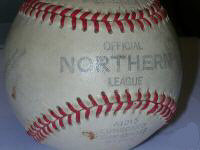 8-13-13
8-13-13
Ten Game Winners - short season (1965-1971)
Short Season Attendance
(1965-1971)
The Northern was a good example of a successful mid-twentieth century baseball minor league. The original organizers were entrepreneurs, but the league was kept alive over it's thirty-six seasons (1933 through 1971 with a three-year interruption due to World War II) by thousands of community volunteers who felt that baseball added greatly to the quality of life in many of the small and mid-sized towns of the upper Midwest. Over those years, franchises were located in twenty-four different cities in the states of North Dakota, South Dakota, Minnesota and Wisconsin and the Canadian province of Manitoba.
According to long-time League President Herman White, there were a number of former major league players living in the Midwest in the early thirties who had a tough time making a living because of the poor economic times. They included Bruno Haas, Dick Wade, Johnny Mostil, and Wally Gilbert. Haas was a prime mover in the league's beginnings. He contacted people in Winnipeg, Manitoba, and found that he could use Sherburne Park with a seating capacity of 3,500 for games every day except Sundays. He also contacted Dick Wade in Duluth and found that Wade and his father were interested in setting up a team in Superior, WI, until they could use the municipal park in Duluth. Other cities were contacted who had active amateur teams.
Bruno then made the most important contact - Hugo Goldsmith. Goldsmith was a sporting goods manufacturer in Cincinnati who agreed to finance part of the potential league's organizational expenses as part of an agreement by which his company would furnish each team ten dozen baseballs in exchange for their promise to buy their uniforms and equipment from him.
An article in the May 9, 1935, "The Sporting News", tells a slightly different story. As organizers it includes the above mentioned former players but also refers to "a man who had successfully handled minor league clubs". That is believed to be Russell L. Voelz . In it's Feb. 16, 1933, edition was the following reference: "Russell L. Voelz of Minneapolis is one of the active promoters of the circuit [Northern League] and will serve as its most important official holding the dual office of president and secretary and also operating the franchise at Grand Forks. The confidence reposed in his leadership was shown by the club owners in naming him their head for a period of three years." Of course, that news item was probably sent to "TSN" by a league representative - Voelz. His picture accompanied the article and it shows a earnest man in his 30s who was probably a good salesman. Another item printed in a 1934 "TSN" edition added to Voehz' resume as it stated that he was attempting to put together another minor league. In any case, it is assumed that Voelz had much to do with contacting potential franchise owners and acted in conjunction with Haas and the others to get the league started
.
Voelz
The league was officially formed in 1933 and admitted to the National Association of Professional Baseball Clubs as a class "D" league. The mid-season player limit was 14 and the maximum salary per team was $1,200 per month. Teams were organized in Winnipeg, Superior, Crookston, MN, Grand Forks, ND, Fargo, ND and Moorhead, MN (jointly), Brainerd, MN, Little Falls, MN, and Eau Claire, WI. The league estimated that 700 players tried out for the loop's eight teams with most of the talent coming from Minnesota, North Dakota, Wisconsin and Canada.
Some of the teams had more difficulty in the beginning then others. In Little Falls, team owner Joe Bieganek experienced a "bit of difficulty" in acquiring the Little Falls ball park for his team, but it was reported in "TSN" that differences would be eventually ironed out. Also mentioned was the information that President Voelz had considered giving that franchise to Wausau who had asked for a berth in the league. In April 1933, owner Bieganek claimed arrangements had been made for the installation of lights for night games and they were described as "good as any to be found throughout the Northwest."
However, Little Falls withdrew from the league and the franchise was given to Thief River Falls, MN, where local business men were confident they would put together a winning team. Franchise owner Bieganek said he had received no "financial or moral support" from fans in Little Falls and that it would be "useless to try to run a team under the circumstances." It was another false hope. Two days before the start of the first 126-game season (with opening day in the first week of May and the last game on Labor Day), Thief River Falls dropped out and the league played the 1933 season with seven teams which caused recurring open days for the remaining teams. According to White, these dates were filled with games against local amateur teams that sometimes did not even cover travel expenses. There were other franchise shifts that first season which are outlined in the "team histories" portion of this history.
Russell Voelz did request that Lute Boone be treasurer "as the Grand Forks owner did not wish to be the league's lone officer." By late August, Boone became president of the league as the league's owners deposed of Voelz when he was charged with "inability to handle league affairs in a proper way." He returned to his home in Minneapolis after a season where he was at various times: 1) the owner of the Grand Forks club, 2) the president of the league and 3) the Eau Claire's team owner.
Herman White's explanation of the change was that Voelz, upon election, "was instructed to set up an office in Grand Forks, buy a typewriter, and hire an assistant. But this was never done because no funds were provided. So there was no office for the clubs to report to until later in the season. In mid season the player-managers of four teams met at a highway intersection as they traveled to their next playing sites. They discussed their dissatisfaction with Vold (sic), removed him as president and named Danny [Lute] Boone of Crookston to replace him."

Boone
Voelz was not happy with the action and sued the league for $21,000 which included $1,200 for lost salary and $20,000 for slander [as reported in "TSN"]. He claimed he had been removed from office illegally. According to "TSN", the action was dismissed by District Judge James Montague on motion of counsel and Voelz eventually settled for $140. White recalled that "the case was brought in the Polk County Court in Crookston. After the directors had made two fruitless trips at their own expense to be present at the trial and the plaintiff failed to show up, the judge agreed to dismiss the complaint. There was one condition: the court costs had to be paid. No one knew where Vold (sic) was, so the only party left was the league. The league's attorneys advised the court that the league treasury contained only $30.47 with no prospect of raising more. Whereupon the finding for costs was set at $30.47 and the court was paid. The defense attorneys, O'Brien & Silvestri, of Crookston, were never compensated."
It was reported that in their first season, most of the clubs made money despite investments in ball parks and equipment. The second season was a greater success with Winnipeg drawing 108,000 fans with crowds of 4.000 not uncommon, but still four applications for membership in 1934 were rejected. "There were plenty of them eager to get on the band wagon after we had proved that a sensibly-handled outfit could be turned into a money-maker," Bruno Haas was later quoted in "TSN". "We are only a class D outfit, but we are well on the way to becoming a permanent and substantial league. All of the old-timers, like myself, try to keep in the line-up at least part of the time. The average age of the players is around 19 years and much of the strength is recruited from college men, graduates of the innumerable amateur leagues in Minnesota and the sand-lots generally. That we play a good caliber of ball is proved by the fact that a least a dozen of our boys went up to the big leagues or the large minors for trials this spring [1935] and most of them are sticking...all of us stick to our agreements on salary and player limitations and we really haven't had a serious headache [he obviously omitted the Russel Voelz situation of 1933].
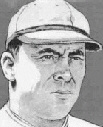
Haas
Haas also said: "We should do even better this season [1935], for we have some solid combinations...Duluth, across the bay from Superior...means those two clubs will be able to capitalize on the keen natural competition between them. The Fargo-Moorhead and Grand Forks-East Grand Forks duos provide a similarly lucrative set-up. Then there's nearby Crookston to round out a Big Three with the loop and provide a fine competitive arrangement."
Haas seemed proud of the fact that the league's teams did not have to maintain a carnival atmosphere to draw fans. They had ladies days weekly and most teams played twilight games. In Winnipeg they started their games at 7 PM and it did not get dark until 10 PM. Bruno also stated that the league had been successful because they did not expand before the loop was well seasoned. One of the league's worst problems was the fact that Sunday baseball-for-admission could not be played in Winnipeg, Grand Forks or Fargo. However, the league did play Sunday games in East Grand Forks, MN, and Moorhead, MN.
The league's operating philosophy was explained by Haas: "We have cut corners, but we have not neglected our men and on the road we always stop at the best hotels, which give us good rates. We have used private busses and automobiles for traveling since in probably half of the cities, rail services is confined to a train or two a day, at least in the direction we need to travel."
By May 1935, "TSN" claimed the league was "one of the most substantial class D units in the organized ball structure". But it also was easily the one covering the most distance. Herman White recalled: " The distance from Eau Claire to Winnipeg was some 350 miles of rough, mostly graveled road. Later, when Wausau replaced Brainerd, it became 650 miles. To illustrate this great expanse, one Wausau player figured out that if his club should become confused in direction and traveled an equal number of miles east instead of west the team would pass Pittsburgh's Forbes Field by some four miles. Even if the clubs could have stood the expense, travel by rail was impossible because of both train and playing schedules. There was the same problem with public bus travel. Of course, there were no lighted parks in the league, so all games were played in the daytime or as twilight games. This and the long trips made overnight trips necessary. The Winnipeg club purchased a used Greyhound bus and that was the talk of the league. Most of the clubs traveled in two seven-passenger, secondhand cars, with a trailer behind one of them to carry the team's baggage. In as much as the player limit was 14, there was not much room for a player to sleep or even to rest. It was fortunate that these players were young and could recuperate quickly. (Remember that they might also have to find room for an umpire to ride with them. He was not always welcome.) Usually one car was driven by the club manager and the other by a player. If the club did not have a playing manager, it meant one more to carry or that the club would have to go with one less player.
"As the seasons went by, one club after another purchased small 15- to 18-passenger buses which were a great improvement. Because of the rough roads and the heavy overloads, it was often necessary to send an extra set of tires to the club on the road in order to insure that it would be able to make a complete trip around the league.
"The Duluth club was one which had an 18-passenger bus. On the morning of July 24, 1948, a quiet, sunny Saturday, the club was traveling from Eau Claire to St. Cloud, when on Highway 36, in St. Paul, Minn., between Dale Street and Western Avenue, a heavily loaded large truck crossed the center line on a rise in the road and collided almost head-on with the players' bus. Both truck and bus burst into flame from ruptured gas tanks. Some persons working in a nearby field and passing motorists pulled a few of the players from the bus before they were burned too badly, but three players were either burned to death or killed in the crash. Both the truck driver and club manager George Treadwell, who was driving the bus, were also killed." [For much more information on this tragedy, please see the 1948 season highlights page].
By 1935 the salary limit was $1000 per month for each league team. Each player could make no more then $75 monthly exclusive of the managers.
Originally, the league hired only four umpires at modest salaries with no expense allowances. In addition, each team arranged for a local umpire for their home games. Their transportation was provided by the teams, but that meant they had to travel with the league's players. In 1936, the league employed eight umps and provided for their transportation by paying one man of each pair for the use of his car. Beginning in 1938, the league served as a training ground for American League umpires with the major league subsidizing their salaries.
Before the 1936 season, Herman White of Eau Claire became the league president replacing Lute Boone. He was born on October 29, 1894 near Necedah, Wisconsin. When he was young, he played sandlot baseball and later pitched for Germantown in the Wisconsin Valley League until an arm injury forced him to stop. He married Frieda Stehle at New Lisbon, Wisconsin, on June 16, 1920 and in the following year settled in Eau Claire, where he began working with an uncle, A. E. White, and a brother, H. A. White, in the White Machine Works which manufactured engine parts. White became a distinguished business and civic leader in Eau Claire, including service as mayor and city councilman. He was also well-known for his philanthropy, particularly toward Luther Hospital in Eau Claire, as well as the Boy Scouts and the YMCA. He was a president of the Eau Claire Area Chamber of Commerce and Eau Claire Rotary Club. During World War II he was county chairman of the Selective Service board.
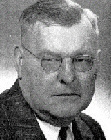
White
As far as the Northern League history was concerned, he was it's Kenasaw Mountain Landis - not in temperament but through his steady leadership. Excluding the war years of 1943-1945, he served continuously from 1936 through 1957. White was also the first Class "D" league president ever to be chosen as a member of the National Association of Minor Leagues executive committee, to which he was re-elected for four consecutive terms and he served as chairman for three terms. He was also a promoter of the Wisconsin State League as a Class "D" professional loop and continued as its president for ten years.
White's last few years at the helm was not without difficulty. In November 1951, he announced at a league directors meeting of his intention to resign his post after the 1952 season and the next Spring he reiterated his intention. However, it was reported at the time, that he might agree to stay if some of the president's responsibilities were removed. It was suggested he could be chairman of the board with a vice president or handle some of the league's administrative details during a season. He had also planned to end his stay on Minor League Baseball's executive committee. Despite that, it was said he had agreed to run for re-election because he felt loyalty to friends who urged him not to retire at such a critical time for the minor leagues.
Prior to the beginning of the 1953 season, the league directors named Hal Totten as League Executive Secretary to relieve White of much of the detail work connected with his office. By July, it became oblivious that White and Totten were not seeing eye-to-eye as, at a league meeting on the 6th, White announced his resignation. It was clear that he had conflicts over the operation of the league with Totten. In a letter to the club's directors, he stated: "Because of the last two paragraphs of your executive secretary's July 1 bulletin to you, I feel it impossible for me to give any further service or advise to the affairs of the Northern League." Totten was a baseball announcer in Chicago for many years and manager of a radio station in Keokuk, IA, before he was elected president of the Three-I league for 1952. He combined the operation of that league and the Northern from headquarters in Cedar Rapids, IA. In the bulletin referred to by White, Totten had declared he was "disgusted" with what he called a "campaign of vilification" conducted by the "president of this league against this office." Reportedly, the two also disagreed over the assignment of umpires.
During the day of the league's All-Star game (July 13), the club directors held a three-hour special meeting to consider White's resignation. The directors voted 5-3 to refuse his resignation and then made it unanimous. After the vote, Executive Secretary Hal Totten submitted his resignation which was accepted by the league's leaders. "There is no personal bad feeling between myself and White," Totten said after the meeting. "He challenged and I was beaten, just as in any sport. I wish Herman all the luck in the world, and also the continued success of the Northern." White said he would give up his civic work as much as possible to devote more time to the league, serving both as president and secretary. He said that Barney Neary, his former aide for 15 years, again would be his assistant.
Again on September 15, 1956, White attempted to retire from baseball. He was a member of the Executive Committee of the National Association of Minor Leagues and the Joint Committee on Revision of the Major-Minor Agreement, representing class C. He said that increased pressure from an expanding personal business was the main reason for his retirement at age 62. The league formed a committee to nominate a successor. The Sporting News stated that White "will leave his post after building the Northern League into one of the strongest in the minors. It is one of only two leagues in the country so far in which every club has been offered renewal of it's working agreement for 1957." In the end, White was persuaded to continue as league president for 1957 but with Barney Neary serving as League Secretary. By June, White announced he did not plan to seek re-election and would resign as a member of the executive committee of the National Association.
In 1958 and 1959, former Aberdeen club President Pete Bradbury served as Northern League President with Barney Neary continuing as Executive Secretary. In September 1959, Bradbury announced his resignation effective in November. He said he found that the job required "too much time and effort away from my business". Bradbury was a road and building contractor. He suggested that a full-time executive officer by hired by the league and recommended Neary. However, the league directors turned again to Herman White and he did not fail them. He stayed on through the 1960 and 1961 seasons completing 21 years of honorable service to the league and baseball. White died on October 29, 1976.
More league highlights during White's tenure:
1941: The league became a class "C" circuit. The league also changed their rules regarding it's teams roster requirements. The new requirements, for each team, were: 4 rookies, 4 limited service (with less then 3 years experience) players and 7 veterans. Rookies were defined as those players with less then 45 days of pro baseball experience. There was an exception to the veteran limit rule in that it would not apply this year in cases where players with more than 3 years' experience were back with the same teams as they were in 1940. The same applied to limited service men, but each team had to have 4 rookies at all times.
1946: The league decided to set the maximum salary limit, for each team, at $2,200 per month including the manager's salary. They also eliminated the 3 cent league fee on any ticket sold for less then 15 cents. It was reported in the May 16 edition of "The Sporting News" that discussions had taken place to limit night games and travel for minor league teams because of a nationwide shortage of coal. Each league was surveyed with Northern League President White being quoted as follows: "Light sources are hydro-electric and coal shortage does not affect league whose clubs use buses [not coal fueled trains]."
In the July 10 edition of "TSN" an article appeared regarding minor league transportation safety [in light of a bus accident which killed 9 members of Spokane's Western International League team]. White was asked for his assessment of the league teams' bus transportation and he stated: "The Northern League is one of the more fortunate circuits, as seven buses, owned by the clubs are new...and the other is leased. In addition, all of them are regularly inspected."
1947: The league's schedule was shortened to 128 games. It opened on May 6 and closed on Labor Day (September 1). In the past, the seasons had ended about September 9.
Organized baseball set limits on the radio broadcasts of major league games in minor league cities. There would be no games broadcast by stations located within 10 miles of a minor league team without the affected teams' consent.
Fargo-Moorhead President Steve Gorman protested the league's proposed schedule for the season which includes 126 games played in 119 days. Dick Wade of Duluth said that there were too many road trips and the schedule was too compact for the May 6-September 1 time frame. The league directors voted to change the playoffs to best-of-five series. The daily meal money was increased to $2.50 and President White asked each club to make sure they would be in compliance with rules regarding "national defense" players, rookies (at least 4 required) and veterans (only 4 allowed).
In the June 18 edition of "The Sporting News", an article appeared regarding the minor leagues' day-to-day living conditions. The Northern League entry was: "Several of first-class hotels will not accept clubs because of alleged misconduct of players, forcing use of others with inferior accommodations. Hotels: Cataract - Sioux Falls; Sherman - Aberdeen; Bison - Fargo; Columbia - Grand Forks (but most clubs moved into dorms at U. of No. Dak. during summer); McKay - Duluth; Androy - Superior; Galloway - Eau Claire; St. Cloud - St. Cloud. Travel by bus driven by players or manager. Private room rates reasonable - around $3.50 per week. Meal money - $2.50."
1948: League President Herman White returned as president and was the chairman of the executive committee of the National Association of minor leagues.
White was named Vice President of the National Association and would serve on the boards governing three inter-league series.
1950: Opening day was set back from May 2 to May 5 because of cold weather and the fact that snow was covering several of the team's fields a few days before the scheduled season's start. The league schedule was changed to play the games missed from September 5 to 8.
Due to flooding throughout the upper Midwest, five of the league's teams had yet to play a game by May 11.
1953: By a vote of the teams, the league rejected an attempt to increase the veteran player limit from 6 to 8. The following rules remained in effect: 1) Each team is permitted not more than 6 "veterans", 2) each club must have at least 2 rookies and 3) they are allowed only 8 "limited service" men. The league also decided to amend the rule that allows home teams to keep all of their gate revenue. In 1954, visiting teams would get 10 cents for each admission with a $50 guarantee. Seven "booster" games would be allowed each club when the visitors would receive $100 and the league $35.
League President Herman White proposed a drastic realignment for the circuit. He suggested the establishment of a Red River Valley League and another separate circuit with "the eastern cities of the present Northern League as a nucleus." Making up the latter group would be Eau Claire, Superior, Duluth, St. Cloud, with LaCrosse, Rochester. Madison and Winona also possibilities. The Red River group would be Winnipeg, Brandon, Fargo-Moorhead, Bismarck, Grand Forks, Aberdeen and possibly Williston, Austin or the return of Sioux Falls. "This would not invade any of the present territory of the Wisconsin State League. If the State League ceased operations, however, cities like Green Bay and Wausau would be in line for top consideration," White said. He mentioned he had heard reports that teams at the southern end of the Wisconsin State League would find it difficult to operate next year. He declared that he had always believed that clubs in the Northern and Wisc. State leagues, which are able to continue operations, could be realigned to "a great deal of advantage." "It is my belief", he stated, "that clubs in Fond du Lac, Janesville and Sheyboygan would have very small opportunity to operate at a profit in view of the tremendous statewide spirit emphasized in favor of the Milwaukee Braves. It is pretty hard to sell the public a ton of enthusiasm for an operation in close proximity to a major league show." Before such a realignment could be accomplished the clubs involved would have to work out a basis of membership. "It will require the work of someone versed in professional baseball operations to set up the proposal as the greater work or beginning of such a realignment," White continued. "It will require work being done in the very near future if such realignment is to be accomplished in time for the preparation of schedules and other matters for the 1954 season. I surely believe that the plan has merit and good prospects for success."
1955: League President White discussed expanding the league to 12 teams for 1956. Additions may be Wausau, Sioux Falls, Green Bay and Port Arthur-Fort William (Ont.). He hoped that more regional rivalries would help at the gate. Attendance figures for 1955 show a decrease by approximately 90,000 from 1954 - when the league "lost a little money".
1956: A July report stated that there was only a 50-50 chance of the league operating in 1957. President White denied it. He declared, although attendance was down, there was every indication that all eight clubs would continue.
1957: The league played a split-schedule in 1957 with the first and second half winners meeting for a playoff after the regular season.
1959: Beginning with the 1959 season, the roster limit was increased from 16 players to 17. Also, the team salary maximum was boosted from $3,600 to $4,200 per month.
1960: At the league's annual meeting, it was decided to increase the umpire's expense allowance from $25 to $30. Umpires salaries ranged from $350 to $375 a month.
1961: The Player Development committee of the National Association discussed if the major leagues should continue to fund aid to minor league teams. The fund had distributed about $800,000 annually. Depending on the league classification, each team received from $20,000 (AAA) to $3,000 (D). Northern League President White was a member of the committee.
1962: Former league president, Herman White, was still a member of organized baseball's major-minor league committee who met in Chicago to discuss the minor leagues' various problems.
From 1962 through1964, the league president was Brooks Baukol of Grand Forks. His reign was not easy:
1962: At a league meeting, Eau Claire and St. Cloud officials said they were in bad straits financially. League President Baukol said he would propose, to the major leagues, that they take over full responsibility for developing players in the league. He also suggested that each parent club pay the full salaries and transportation from spring training to the league cities for all players. The teams would then handle all obligations concerning operations in each city. He criticized the majors for allegedly underwriting semi-pro and amateur leagues such as the Basin League.
1963: The league, which was now designed as "class A" was back to six teams.
In July, the league's directors overturned a decision by League President Baukol regarding a protest of the game between Grand Forks and St. Cloud of July 16. There is no record of a decision of Herman White's ever being overturned.
The league decided not to stage a playoff championship after regular play. Instead they will maintain separate standings for the last 30 scheduled games of each team. The winner of that "mini-season" will be declared the playoff champ. The idea came from the league president and, therefore, gained the title of "The Baukol Playoffs".
1964: In August, it was announced that Duluth-Superior had lost their working agreement with Detroit and Winnipeg it's relationship with St. Louis for the 1965 season. In addition, it appeared that the Dodgers were about to pull out of Grand Forks and officials there were concerned about park facilities. President Baukol said: "We realize the situation is more serious than at any other time and it is going to take a lot of work to keep the league operating." A league directors meeting was scheduled to be held in two weeks. In 1964, the league's teams drew 16,608 more fans then in 1963.
The Northern League was recognized as the oldest continually operating league in the U.S. below the "AA" level.
1965: A body blow was sustained by the league when major league baseball consolidated the minor leagues and reduced the Northern League's status to "rookie" although second year players were also assigned there. This meant that the season was cut one-half to 66 games (opening day was June 27 and the season ended on September 2) which significantly reduced the caliber of play which led to a period of instability. Thereafter, teams came in and out of the league more frequently (please see "team histories" pages), and the number of teams went from eight to fluctuating between six and four. The lack of stability, low level of play and shorter season began to drive fans away.
It was not known until April 5 if the league would even operate in 1965 after the loss of the 3 teams.
Before the start of the 1965 season, Roland Parcel of Aberdeen, became the president of the league and did every thing in his power to save it from extinction for the next six years. In a October 11, 1966, "The Sporting News" published a study of Parcel (it was written by long-time Aberdeen sportswriter, Larry Desautels) which included a picture of him with his airplane. The article said: "When Roland Parcel took over as president of the Northern League in February 1965, he had two ball clubs, one working agreement and an airplane. The airplane has been one of his most useful items in salvaging the league and administering it's far-flung territory. 'I'm just an hour and 45 minutes away from the farthest point in the league and when there's trouble at any spot, I can get there in a hurry.
'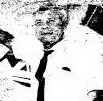
Parcel
"Parcel, who serves as league president without pay, logs over 6,000 miles per year on Northern League business. Before entering the oil business [Parcel Oil Co. in Aberdeen], several years ago, he was a commercial airlines pilot. The league has thrived under Parcel. When he took over, only the Aberdeen club was ready for the 1965 season with a working agreement with Baltimore. The Duluth-Superior club was willing but had no working agreement. St. Cloud and Bismarck-Mandan were reluctant to quit but were having financial problems and neither had a working agreement. Grand Forks had lost it's ball park to a super highway and Winnipeg had decided to drop out of the league.
"St. Cloud and Bismarck-Mandan were persuaded to go along in a four-team league if working agreements could be secured. Backing Parcel in his bid to keep the league alive were Jim McLaughlin of the Cincinnati Reds and Harry Dalton of the Baltimore Orioles. 'Without them, we would have been sunk,' Parcel said. 'But they helped us get the working agreements.' Just when all the problems appeared to be solved, Bismarck-Mandan decided to withdraw, but Huron showed an interest and wound up taking over the franchise just in time for the 1965 season.
"The 1965 campaign was strictly a battle for survival. When it ended, all four clubs were in good financial condition, with Huron drawing 44,001 for 32 home games to set the pace. Parcel found two more working agreements for 1966. Bismarck-Mandan returned to the fold and Sioux Falls became a sixth team. With all six clubs already announcing they will be set to go in 1967, the league is enjoying it's most solid standing in many years. The Northern League is the oldest of the lower minors. Except for three years during World War II, it has operated continuously."
Parcel's service to the league ended after the 1970 season. For 1971, Art White of Sioux Falls, became the final league president. In the February 12, 1972, edition of "The Sporting News", the "Aberdeen American News" sports editor, Larry Desautels wrote the Northern League's obituary:
"The Northern League, born in the depths of the Great Depression, came to the end of its run January 22 when League President Art White announced that it was impossible to find two more cities to replace Sioux Falls and Duluth, which had voted not to operate in 1972. This left Aberdeen and St. Cloud as the only remaining teams.
"The league established two baseball records during its existence. It was the oldest of the lower minors, beginning in 1933 and operating continuously since that time except for three World War II years. And it had the longest working agreement in the history of baseball.
"The Aberdeen Pheasants joined the league in 1946 and signed a pact with the St. Louis Browns. When the Browns move to Baltimore, the Pheasants remained part of the family. The 1972 renewal, signed at the close of last season, would have been the 27th. The Northern League started with teams in Brainerd, Crookston and Duluth, Minn; Grand Forks and Fargo, N.D.; Eau Claire, Wis., and Winnipeg. The seven clubs played traveling teams on their open dates in an era when the House of David, Kansas City Monarchs and other barnstorming troupes toured the country. Satchel Paige pitched in several games against Northern League teams.
"The end came when Duluth, which tentatively agreed to
replace Watertown, decided not to operate and was joined by Sioux
Falls. That left only Aberdeen and St. Cloud from the four-team
league of 1971. The Aberdeen club probably was the most successful,
ending its run with assets of about $20,000. Under present plans, the
money will be kept in a special fund with the annual interest being
used to assist amateur baseball programs..."
--------------------
The Original Teams 
Winnipeg , Manitoba, was the largest city in the league with a population of more then 200,000. Early on, they got around the no-Sunday games at Sherbourne Park rule by moving those games to neighboring St. Boniface where they made an agreement with the local Catholic Church to play on a pass-the-hat basis under the church's auspices. Also the "Maroons" sometimes played split double headers at Sherbourne on Saturdays. The league treasured the Winnipeg franchise because of their good attendance and the rules required visitors to share in the home team's gate proceeds, provided much needed revenue for all teams. This lead to games always being scheduled in Winnipeg on Canadian holidays in order to drive up attendance figures as much as possible. Bruno Haas eventually sold the team to a Winnipeg group headed by Charles McFadden for $10,000 which was a record price, at that time, for a class "D" team. The franchise did not survive in the city during the league's World War II hiatus and was moved to Aberdeen, SD, before the 1946 season. The city returned to the league in 1954 as the "Goldeyes" and left again after the 1964 season. They tried it one more time in 1969.
In 1954, Winnipeg Stadium was built which was originally a good
baseball park. At the same time, it was also used for football and
other events. The park had problems with clubhouse facilities for
baseball, so teams had to use the football dressing rooms or go
across the street to the Winnipeg Arena for a shower and to change.
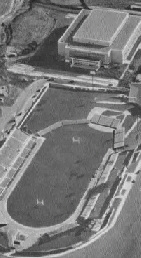
Winnipeg Stadium in the late 1950s (courtesy Gene Madaio)
In 1979, the baseball complex was virtually destroyed when the CFL football "Blue Bombers" rebuilt their field house over to the left field dugout. That expansion also carved into the third base line and made the field basically unplayable for baseball. Then the grandstand was destroyed in 1984. The old baseball portion of the stadium is now at the location of the Blue and Gold Room.
In 22 years in the league, Winnipeg teams earned a .523 winning
record with five first place finishes and six playoff victories. Over
those years, they were managed by well-known baseball men including
Bruno Haas (8 seasons), Joe Mowry, Mickey O'Neal, Vern Benson, Whitey
Kurowski and Fred Koenig. Former players who reached the majors
include Steve Carlton, Doug Bird, Julio Gotay, Tom Heigendorf, Ellie
Hendricks, Larry Jaster, Coco Laboy, Johnny Lewis, Dal Maxvill, Von
McDaniel, Ray Sadecki, Jimmy Schaffer, No Neck Williams and Jim York.
They were affiliated with the Pirates in 1936, the Indians in 1937,
the Cardinals from 1954-64 and the A's in 1969.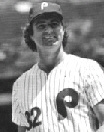
Carlton
[You may view a current picture of
the site of Winnipeg Stadium at:
http://football.ballparks.com/CFL/Winnipeg/index.htm ]
Team
Highlights:
5-34: Each league club found traveling to Winnipeg a financial bonanza as they could pay their entire road expenses from the proceeds of a series at the Canadian city. For the second straight year, Winnipeg led the league in attendance.
9-35: Winnipeg became the 1935 league champs.
5-25-36: Bill Burr of Winnipeg pitched an 8-0 no-hitter against Eau Claire. It was the second no-hitter in league history. Burr, an18-year-old from Columbus, OH, walked 3 and fanned 3.
7-21-38: Linus (Skeeter) Ebnet of Winnipeg died in a Winnipeg hospital from being hit in the head by a pitched ball from Vince Clawson during a game against Grand Forks on July 16. The hospital's medical staff had attempted to relieve pressure in his brain with an operation. Ebnet, who was 23 years old, had played in the league since it's inception. [For a full essay about this tragedy, please see the page "Skeets Killed by Pitch"].
5-39: Winnipeg had lights with 255,000 wattage. The field's dimensions were 341 to left, 400 to center and 300 to right. The park seated 3,500.
9-3-39: Winnipeg finished strongly (won 10 out 14 late road games) to win the pennant with a 72-48 record. Duluth was second with a 71-40 record and Fargo-Moorhead third at 67-48.
9-39: In the playoffs final, Winnipeg won the League Championship
by winning 4 games to Eau Claire's one game.
9-42: After 4
games were played in the series between Winnipeg and Sioux Falls
(each team had won 2 games), it was decided by the league to increase
the series to a best-of-9. That decision was based on Wausau's
withdrawal from the playoffs. Winnipeg won the series 5 games to 4 to
become the playoff champions.
3-46: The Winnipeg franchise did not survive the war and moved to
Aberdeen, SD.
9-53: It was announced that Winnipeg would
return with a team in the league for 1954. They had acquired the
Sioux Falls franchise who had no available ball park after 1953.
5-54: For the ceremonial first pitch prior to their opener, they used the last ball that was in play when the city lost their franchise in 1942.
1954: The team drew their franchise record for a season of 100,458.
9-6-54: Cold and rainy weather forced the cancellation of a double header on the closing day of the season in Winnipeg. It prevented the club from posting a new league attendance record held by Fargo-Moorhead in 1953 of 108,622. The Goldeyes finished the season at 108,081.
6-3-55: Winnipeg drew their largest crowd in history -- 5,656 - for a game vs. Fargo-Moorhead which they lost 5-2.
7-21-55: The president of the Winnipeg Goldeyes, Mark Danzker, said that the city had been offered the Charleston franchise in the American Association. The city declined the offer because of the continuing ban, in Winnipeg, of baseball on Sundays. He stated that there was hope that the law could be changed in the near future.
5-19-56: Mark Danzker, former owner of the Winnipeg Goldeyes, was presented with a plaque from the local sportswriters and broadcasters honoring him as "the man instrumental in bringing organized ball back to Winnipeg." He sold the team to a local syndicate in the spring of 1956.
6-19-57: Winnipeg set a club record for gate receipts for one game when, on "Eagles Night", they charged $2 per ticket and brought in a total of $9,522.
7-11-57: Winnipeg's attendance had been so good (average of 1,943) that they had drawn more fans then 2 American Association teams - Wichita and Indianapolis.
9-6-57: In the third game of the playoff series between the first (D-S) and second (Winnipeg) half champions, Joe Hoerner (D-S) had the Goldeyes hitless through 8 2/3 innings. Winnipeg then scored 2 runs to force extra innings and added 3 more in the 10th to win the series 3 games to 0. In the 9th, Hoerner walked Ed Napoleon, then Wally Alexander doubled and Juan Armenteros hit another double for a 2-0 D-S lead. In the bottom of the 9th, the White Sox tied the score off Cal Browning with a double by Sam Hill, a triple by Dick Lombardi and a single by Don Mincher. D-S brought in reliever Vince Zeimis in the 10th and he gave up a 2-run double to Walt Mathews. The Goldeyes were playoff champions.
9-59: Winnipeg won the pennant with an 80-41 record - 12 ½ games over Aberdeen (69-55).
In the playoff finals, Winnipeg beat Aberdeen 2 games to 1 game.
9-4-60: Winnipeg clinched their 2ndconsecutive
pennant with a 4-3 victory over Minot which was powered by Joe
Patterson's 2-out home run in the 9thinning. Harry Fanok
pitched a 5-hitter for the victory.
9-60: Winnipeg won the playoff championship by beating Aberdeen in a 12-inning semi-final 5-4 and then defeated Duluth-Superior 4-1 and 9-0 for the crown. The decisive game was a 4-hit shutout by Harry Fanok.
5-61: Winnipeg's GM, Terry Hind, announced that he would resign at the end of the year because of a verbal attack by Eau Claire manager Jim Fanning. Fanning blasted Hind for not calling off a game with the Braves, on May 15, because of cold weather. By the end of the game, the temp was 31 degrees. "Let's just say this was another factor which served to influence a decision I've been pondering for a long time." Hind said. He had been the Winnipeg's GM for 7 years.
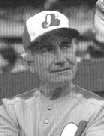
Fanning
7-27-61: Winnipeg manager, Grover Resinger, was transferred to Billings of the Pioneer League by the Cardinals organization. He was replaced by Owen Friend who had been at Billings.
7-28-62: An unbelievable crowd of 10,144 watched home-team Winnipeg beat B-M 9-2 on "Kid's Day". The team had sold 35,000 reduced price tickets to local merchants who gave them away as bonus prizes. The contest's grand prize was a pony.
1963 - The Winnipeg legislature passed a bill which legalized Sunday baseball in the city from 1:30 pm to 5:30 pm.
7-9-64: Rich Masterman of Winnipeg threw a 2-0 seven-inning no-hitter against St. Cloud. The 19-year-old native from Hamburg, NY, struck out 8 and walked 2. He was drafted from the Orioles organization last winter and was playing his 2ndpro year. Masterman was the 1st Winnipeg Goldeyes' player ever to pitch a no-hitter.
1965 - The league lost one of it's oldest member, Grand Forks, their team with the best attendance, Winnipeg, and the Bismarck-Mandan club.
1969 - Winnipeg returned to the league replacing Mankato for the season which was played between June 22 and September 1.
1970 - League membership was changed with Winnipeg dropping out
and Watertown was added.
Winnipeg club's officers:
1940-1941: G.H. McFadyen, president
1954: Mark Danzer, president and bus. mang.
1955: Danzer, presdent and Terry Hind, bus. mang
1956-61: Pete Curry, president and Hind, bus mang
1962-64: Bill Everett, president and Hind, bus mang
1969: Hind, president and Gordie Wilson, bus. mang
Superior, WI (pop. approx 36,000) was operated by Dick Wade's father, Frank, as early on Dick managed and played right field. From 1933-35, they played in a park located in the railroad yards near downtown. The park had a short right field fence and ground rule doubles down the line by left handed hitters were not difficult. Because of railroad switching activities, smoke and steam from the engines would frequently cloud the playing field..
When the Wades moved the team to Duluth in 1936, William Berg headed a businessmen group who continued a "Blues" team and hired Red Treadwell as the manager. A new municipal park was built south of where the Gates Physical Education Building is now on the UWS campus and north of where WITC is now. The team operated there through the 1955 season, when it was moved to Wausau, WI.
In 20 league seasons, the "Blues" compiled a .500
record, two first place finishes and two playoff championships.
Managers during those years included Red Treadwell, Chappie Geygan,
Johnny Mostil, Red Kress and Buster Miles. Former players who made
the majors include Fritz Ackley, Morrie Arnovich, Blix Donnelly, Glen
Hobbie, Russ Meyer, John Ostrowski and Pete Reiser. They were
associated with the Browns in 1937, the Dodgers in 1938-40, and the
White Sox from 1942-53.
Reiser
Team highlights:
9-33: Superior won the playoffs 5 games to Brandon's 4 games. The Blues were the Northern League's first champions.
8-35: A proposal was made in Superior to move the grandstand, bleachers and fences of Hislop Park to another site because of excess soot and smoke caused by train traffic at the present location.
9-2-36: George Tkach of Superior died in Winnipeg from injuries received when he was hit by a pitched ball on August 27. A wild pitch, in the first inning, from Alex Ufferman struck Tkach in his jaw and he was immediately rushed to a hospital but never regained consciousness. Dr. J.A. Hillsman, an outstanding Canadian surgeon, performed brain surgery on August 30 and, the next day, oxygen and glucose were administered. This was Tkach's 2nd year in pro ball as he had played with Rock Island and Crookston in 1935 before signing with the Blues later that year. Along with Don Falstad at shortstop, he formed one of the best double play combinations in the league for 1936 and was very popular with his teammates and the fans. He was 20 years old and lived in Waukegan, IL. [You may read more about this tragedy on the page "Skeets Killed by Pitch"].
8-37: Superior supporters claimed the season a loss but planned to keep the franchise going for 1938. Rain and cold weather kept their spring training candidates off their field until the day before the season's opener. As the weather warmed up, interest in the team also improved, but then injuries took their toll with catcher/manager Red Treadwell being hit in the head by a bat while in his catching stance, Milly Wildeneaur broke a finger grabbing a hot grounder, Marion Cilbrowski and Loyal Hodge suffered sprained ankles and Joe Goldfine broke his ankle. Treadwell suffered dizzy spells and was not in the lineup for some time after his injury.
Early 7-38: Superior was scheduled to abandon Hislop Park by the end of the month for their new park which was built with a $65,000 aid project. The Blue's "Booster Club" was nearing it's goal of raising $2,500 for installation of lights at the new field. After they were installed, Duluth was the only team whose home park was not equipped with lights.
Late 7-38: Superior reached their goal of raising funds for lights at their new park. The first night game was scheduled for either August 14 or 15.
7-28-38: Superior opened their new $70,000 park before a crowd of 2,000. The Blues' Barney DeForge threw a 4-hitter with 13 strikeouts for the 5-1 win over Wausau. Mayor Byrn Ostby threw the ceremonial first pitch to former councilman Charles Peterson. The new park's dimensions helped Blues' outfielder Marion Cibrowski catch up to a deep fly ball that would have cleared the fence at their old park by an estimated 50 feet. During the game, Blues' manager, Red Treadwell, suffered a 3-inch gash on his forehead in the 6th inning when one of DeForge's curve balls hit his mask. Treadwell stayed in the game.
9-5-38: Superior won the regular season pennant with a 78-36 record which was 7 games ahead of Duluth who had a 72-44 mark.
4-13-39: It was reported that the Superior Blues, who had been losing money for six years, had not secured a satisfactory lease for the new Municipal Stadium which was built with WPA funds in 1938. The club offered the city $900 for the season not including electricity costs, which they claimed would be more then any other city in the league would receive. The city park board turned down the offer and asked for 10-15% of the gross revenue, that the percentage could be changed during the season and they indicated the agreement could be terminated with only ten days notice. Blues' president William Berg then threatened to move the team to another city. He also made arrangements to play the first six weeks of the schedule on the road.
5-39: Superior agreed to use the city's Municipal Stadium for the season. The Blues would pay 7 ½ % of gross gate receipts up to an attendance of 45,000 and 10% for any over that mark. Also, the team would keep all concession revenue. The settlement came less then 24 hours before their first game (on the road).
Superior's new park had lights estimated at 172,500 watts and the park's dimensions were 315, 415, 315 with a 3,500 capacity.
4-41: The ownership of the Superior franchise was transferred from William Berg to the Superior Civic Baseball Association. The association had completed a stock plan to raise $6,000, but had raised $9,000. The franchise was purchased for $4,000 which included $1,000 in stock. In the stockholder's first meeting, James Dugan (who was the instigator of the campaign) was named president, and the other officers chosen were: Henry Skudstad, secretary; Ernest Darst, treasurer; and Clyde Thomas (representing the Superior post of The Veterans of Foreign Wars), vice president. The new owners also named Art Hauger manager of the team. He was born in Springfield, MN and was the manager of Pennington Gap (Appalachian) in 1940 from which it was planned he would bring playing talent to the Blues. One of Hauger's first priorities was to determine a location for their training site. Last year's team trained at Minong, WI, which was 50 miles south of Superior and away that region's cold spring lake winds.
7-31-41: In the July 31 edition of "The Sporting News", Bill Stewart of the "Superior Telegram" wrote this story about the Superior franchise:
"A couple of years ago, the Superior club's finances were at
ebb-tide. Bill Berg, former franchise owner, and manager George
Treadwell, now pilot of Johnstown of the Penn State Association,
constantly burned the midnight oil. seeking a solution of the
financial difficulties of the club. The club traveled in two ancient
seven-passenger hacks, and the trips about the Northern League, one
of the most extensive in the minors, were hazardous. The motors
wheezed and the tires popped with disconcerting regularity. While the
team was on a 500-mile jaunt to Winnipeg, Man., one of the frayed
tires gave out completely. That night, Treadwell wrote to President
Berg: 'Tire on one of cars completely shot, and cash account
likewise. Had to release righthanded pitcher to make both ends meet.
He was a good boy and we could use him, but we need the tire worse.
We can make it home without the pitcher, but not without a tire. Got
a good second hand buy.' Regards, George"
4-46: Superior
secretary Al Eastman and stockholder Art Simonsen were planning to
see many of their team's out-of-town games by traveling on an
airplane. Both were experienced amateur pilots and Simonsen, who
sells candy and tobacco, owned a plane.
8-46: Fred Hensley resigned as manager at Superior. He had received an "attractive" offer for a full-time job that he could not turn down. George "Red" Treadwell returned to the league to manage the team. He had been the Blues' manager from 1936 through 1939, a manager in the Penn State Assoc. in 1940-41 and had been overseas with the Seebees during the war.
7-27-47: Red Treadwell resigned as manager of Superior after the Blues dropped to 7th place. Al Hanley, a 26-year-old infielder, was named acting manager.
8-1-47 Red Treadwell returned as manager of Superior. He quit 6 days previous because he thought his resignation would "help the team." He was induced to reconsider.
7-27-49: Superior fans packed their ball park to watch a double header against port foe Duluth. A crowd of 5,539 saw the Blues split the twin bill with the home team winning the opener 9-3 and losing the night cap 4-2.
Mid-July, 1950: Red Kress replaced Bennie Huffman as manager.
Kress had been the skipper at Sacramento (PCL) until June 1. Huffman
had managed Waterloo (Three-I) in 1949 and left with the Blues in 3rd
place.
Kress
1949: The club set their franchise season attendance record of 76,417.
8-50: A group of Superior Blues backers gave the team a check for $2,035 to purchase all of the tickets of their home game against Grand Forks. They then allowed any fan into the game free. The promotion drew more then 5,000 people to the game.
Due to financial problems in 1949, the Superior franchise was leased by the White Sox in 1950 and they reportly lost about $17,000. Therefore, the White Sox gave the club back to Superior businessman before the 1951 season. The local owners operated the team with the White Sox only supplying player talent.
5-18-52: Gideon Applegate pitched a 3-0 no-hitter for Superior over Sioux Falls. The righthander faced only 29 batters, walked 5 and struck out 6. One of the Canaries' base runners was thrown out attempting to steal, another was picked off first and a double play erased another. The crowd held their collective breath when George Beck's fly ball to right fielder Bob Bennett backed him up to the fence. Applegate, from Rumford, RI, was in his 4th pro season having played at Kingston (Border) in 1949-1950 and Waterloo (Three-I) in 1951.
6-16-52: Gideon Applegate pitched another no-hitter (this one a 7-inning 9-0 win) against St. Cloud. Applegate, who was African-American, struck out 11, walked 3 and contributed at the plate with 2 doubles. He was on option to Superior from Colorado Springs (Western).
9-1-52: Superior won the league pennant with a 81-42 record which was 7 games better then 2nd place Sioux Falls (73-48).
9-52: Superior won the playoff championship by defeating Sioux
Falls 3 games to none. It was the first time since 1948 that a team
had won both the regular season and playoff titles.
5-54:
Superior lost their GM, W. S. Hahn, as he resigned. Team President
Tom Fleming will handle his duties temporarily.
6-55: Tom Fleming, the president of the Superior Blues, announced that he planned to resign unless attendance picks up. The club only drew 7,366 in the first 7 games of the season and were far behind last year's figures.
Winter 1955-56: Superior gave up their franchise and became part of a combined Duluth-Superior club. Wausau replaced them.
Superior club's officers:
1940: Bill Berg, president
1946-49: J.P. Dugan, president
1950: Howard Underhill, president
1951-52: Clyde Thomas, president
1953: Thomas, president and Berg, bus. mang.
1954: Tom Fleming, president and W. S. Hahn, bus. mang
1955: Fleming, president
was the league's second largest city (pop.
100,000) and for the first few years operated in the park that was
used in the 1913-16 version of the Northern League. In 1941, Wade
Stadium was built as a WPA project to seat 4,000. Extending from each
side of the grandstand, is an enormous wall, which like the exterior
of the park in comprised of old bricks that were removed from the
streets of downtown Duluth during a repaving project. These walls
continue in a straight line until they meet up with the outfield
wall, which is considerably shorter and made of concrete. Since the
brick walls parallel the foul lines there is quite a bit of room
between the lines and the field. Baseball is still being played there
through the summer months.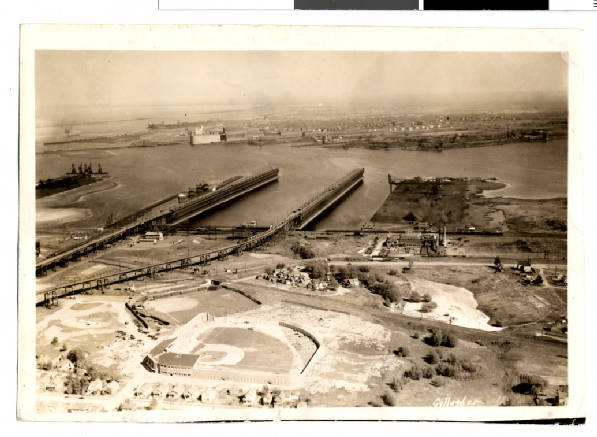
Wade Stadium in the early 1940s
The "Dukes" operated in 1934 and 1935 with other owners, but Frank and Dick Wade took over in 1936 and the team continued as such through 1955, when it became the Duluth-Superior "White Sox" for three years and then the "Dukes" nickname returned until the team's demise after the 1970 season. No other Northern League city supported a to many years - 34 - as Duluth did. In only two of the league's operating years did a Duluth franchise not exist.
The Dukes and the White Sox had a .512 win/loss percentage,
finishing in first place six times and won three playoff
championships. Managers included Dutch Dorman, Orie Arntzen, Joe
Hauser, Frank Carswell, Bob Swift, Al Lakeman and Ira Hutchinson.
Duluth player alumni who reached the majors include Hank Aguirre,
Cloyd Boyer, Gates Brown, Ike Brown, Bill Butler, Cam Carreon, Wayne
Comer, Bill Freehan, Dennis Higgins, John Hiller, Joe Hoerner, Willie
Horton, Pat Jarvis, Lemar Johnson, Andy Kosco, Jack Kralick, Danny
Litwhiler, J.C. Martin, Denny McLain, Jerry McNertney, Don Mincher,
Jim Norhrup, Dan Osinski, Ray Oyler, Jim Rooker, Willie Smith, Joe
Sparma, Mickey Stanley and Tom Timmermann.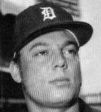
Hiller
Their major league affiliations were with the Cardinals from 1937-50, the Reds from 1954-55, the White Sox from 1956-59, the Tigers from 1960-64, a combined Tigers and White Sox arrangement in 1965, the Cubs in 1966, a combination Cubs and White Sox agreement in 1967 and the White Sox from 1968-70.
Team highlights:
9-37: Duluth won the regular season pennant with a 81-39 record which was 6½ games ahead of F-M (70-41).
In the playoffs final series, Duluth beat F-M 4 games to 2.
6-38: Due to the overflow crowds for Sunday games in Duluth, the club increased the seating capacity of it's park to 3,450. The team also scheduled an old-timers game for July 2 which would include former star players from their area.
9-38: Duluth beat Crookson in the playoff finals 4 games to 3 games.
5-39: Duluth's park was the only league playing field that did not have lights.
5-40: Construction on a new ball park in Duluth began. The completed park was scheduled to cost $152,000 and have lights. It was expected to open by August 1.
9-2-40: Joe Shroba (Dul) pitched the league's 3rd no-hitter of the year. His was a 7-inning no-no against Superior which the Dukes won 4-0. He struck out 12 and walked 2 during the 2nd game of a double header.
7-41: Duluth traded their manager/pitcher Joe Davis to Decatur (Three-I) for Howard Taylor who immediately became their manager/pitcher
8-26-41: Duluth pitcher Frank Mottley hurled a 7-0 seven inning
no-hitter against Grand Forks. He struck out 7 and walked only one.
3-42: Duluth manager Eddie Malone was probably the youngest
manager in pro baseball. At age 21, he had already played
professionally for 5 years.
Malone
8-4-46: Ted Novak, a Grand Forks pitcher, threw a 3-0 no-hitter over Duluth. Two Dukes reached base on ground ball errors in the 3rd and 4th innings. Novak did not walk anyone, had a 3-ball count on only 3 batters and struck out 3. That season he was one of the league's oldest players in service and years, was a World War II veteran and had been used only sparingly, during the season, because of arm trouble.
1947: Duluth drew their highest season attendance of 107,548.
7-24-48: Four members of the Duluth Dukes and their manager were killed and thirteen players injured in a bus-truck accident just north of St. Paul, MN. The Dukes 18-passenger bus was traveling from Eau Claire to St. Cloud on highway 36 between Dale Street and Western Avenue. A heavy large truck loaded with dry ice crossed the center line after hitting a rough spot in the road, bounced out of control and collided almost head on with the team's bus smashing it over on its side into the ditch. Both the truck and the bus burst into flames from ruptured gas tanks. Persons working in a nearby field and passing motorists pulled all but 3 of the players from the bus. Both the truck driver and manger Red Treadwell (age 42), who was driving the bus, were also killed. The dead players were Gerald Peterson (age 23) of Proctor, MN; Gilbert Krirdla (age 19) of Duluth and formerly from St. Louis, who played under the name of Gilbert Tribble; Don Schuchman (age 20) of St. Louis and Steve Lazar (age 23) of Olyphant, PA. who died 2 days after the crash.
Seven other players were critically injured and the remaining seven sustained minor injuries: Sam Paitich, of St. Paul who joined the team only one week earlier, had burned hands and legs; Don Gilmore, of Columbus, OH, was burned on his right hand, his right ankle was fractured and his right foot badly cut; Bernie Gerl, of Joliet, IL, was critically burned; Don Vanderwier, of Muskegon, MI, sustained a lacerated lower back; Uell Clark, of Jackson, MI, had head injuries; John Ritonya, of Omaha, had a fractured arm, leg and lip; Joe Svetlick, of Cinderalla, WV, sustained a bruised arm and leg; Mel McGaha, of Fayetteville, AR, had bruises; Elmer Schoendienst, of Germantown, IL, had bruises; Bill Ward, of Chicago, had bruises and was in shock; Joe Becker, of St. Louis, fractured his left leg and had face burns; Bob Vogeltanz, of Evergreen Park, IL, had a fractured left leg and Bud Dubia, of Murray, KS, had face injuries.

McGaha
In about a week after the accident, the Dukes were able to resume it's schedule. Pro teams around the country donated proceeds from benefit games to be distributed equally among the injured players and the families who were killed.
In was announced that Ted Madeski would manage the Dukes. He was a former catcher from Houston (Texas) who earlier in 1948 had managed Ft. Lauderdale (FL-International). The team's first game was July 31 at Superior which they lost 5-3.
9-48: Contributions to the families of the Dukes' bus accident reached $64,090.54. It was reported that Duluth fans did rally behind the new Dukes even though they fell out of playoff contention. Only one member of the original team returned - pitcher Joe Svetlick. The parent Cardinals continued to send help to strengthen the team, but most of the other clubs in the league recalled their loaned players early on. Only Grand Forks held to its commitment.
6-18-49: Herm Miller of the Duluth Dukes pitched a 4-0 seven inning no-hitter over St. Cloud.
7-23-49: Duluth lost their manager, Ted Madjeski, when he was optioned to the Salisbury (Eastern Shore) club. He was replaced by Russ Rolandson who had been a catcher at Omaha (Western).
6-1-51: Ken Blackman resigned as athletic director of Buena Vista College to join Duluth as a pitcher and coach. At that time, he had 9 years of experience as a player and manager.
6-2-51: Duluth's business manager, Duke Zilber, resigned. He had been appointed in January.
6-11-51: Ken Blackman became manager at Duluth. He replaced Orie Arntzen who remained as a pitcher on the team.
5-28-52: Jim Trew quit as manager of Duluth after a 6-13 start. The third baseman/outfielder was succeeded by club business manager, Ken Blackman, who had managed the team during the latter part of the 1951 season. Blackman was slated to be the bench manager with catcher Carlton Nebel acting as "field captain".
6-9-54: Oscar Khederian resigned as the Duluth Dukes' manager after his team lost 7 of 8 games. Dick Wade, who had not managed since 1934, took charge of the team.
6-24-54: Danny Litwhiler became the player-manager of the Duluth
Dukes. In his initial game, he hit 2 home runs and a single to lead
his team to a 15-9 victory over Aberdeen. Earlier in the season,
Litwhiler had been fired as manager of the Jamestown team in the PONY
League.
Litwhiler
3-56: Superior gave up their franchise and became part of a combined Duluth-Superior club. Wausau returned to the league for the first time since 1942.
8-8-56: Jack Kralick of Duluth-Superior pitched a 5-0 seven-inning
no-hitter against Fargo-Moorhead.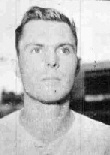
Kralick
9-56: Eau Claire and Winnipeg were eliminated in the playoffs by Duluth-Superior and Aberdeen. The White Sox beat the Pheasants 2-0 to win the playoff championship.
5-27-57: Duluth-Superior had played some of their home games in Superior. However, after drawing only 405 and 368 there on May 27 and May 28, the team announced all home games will be played in Duluth. The possible exception would be the afternoon games of a few split double-headers.
6-7-57: Al McKinney and Joe Hoerner, of Duluth-Superior, pitched a 14-0 combined no-hitter against Winnipeg. McKinney started the game, but had to leave with a sore arm after 3 batters. Hoerner came in at the start of the 2ndinning and struck out 4 and walked 3.
9-2-57: D-S came back to win the league pennant with a 73-52 record which was 2 ½ games ahead of Winnipeg (69-53) and 3 ahead of Eau Claire (70-55).
7-5-58: Joe Hauser was fired as the Duluth-Superior manager after the team had a 6-17 slump and dropped to 6th place. He was replaced by George Sobek who had managed the Superior Blues in 1949 and had, more recently, been a Chicago area scout for the White Sox. Sobek also taught at Thornton High School in Calument, IN. Johnny Mostil, another White Sox scout, had filed in for 2 games until Sobek arrived in Duluth.
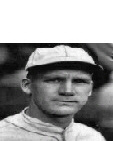
Hauser
6-59: Duluth-Superior had one of the worse poor weather starts in
club history. They postponed 16 of their first 31 games. Team
President's K.A. Nicholson's "day job" was that of a
weatherman
9-4-61: Duluth-Superior finished in first place
with a 76-52 record. Aberdeen (74-54) ended the season in second
place 2 games behind and St. Cloud (73-54) was third 2 ½ games
back.
5-62: Duluth-Superior had a tough month of May financially. The Dukes had 20 games scheduled, but only 8 were played because of very poor weather. The team's president, Ken Nicolson, a Duluth meteorologist, said that rainfall was the 2ndhighest in the history of the city's weather bureau. It rained 25 days during the month.
8-8-62: John Gregory of Duluth-Superior pitched a 2-0 seven-inning no-hitter over Bismarck-Mandan. Gregory, who had signed with Detroit for $30,000, struck out 12 and walked 5. In the 2nd inning, he walked the bases full, but then struck out the next 2 batters. In the 3rd, he struck out the side.
9-63: The Dukes (77-43) won the league pennant by 12 games over Aberdeen (65-55).
6-3-64: In only his 2nd start for the team, Darrell Clark of Duluth-Superior threw a 2-0 no-hitter over Bismarck-Mandan. He walked 4 and struck out 13. The closest the Pards came to a hit was in the 7thinning when Jerry Pritchett hit a drive down the 3rdbase line. Chuck Stevenson made a diving stop but made a low throw to Jim Rooker, who dug it out to maintain the no-no. In his previous start, Clark allowed 4 hits.
7-10-64: D-S President Ken Nicolson announced that he was deeply concerned about the future of pro ball in the twin ports of Duluth and Superior. Attendance was down 10,000 from 1963 and an all-out drive would begin to reclaim their fan base. He also announced that John Nolan, the business manager, would be terminated on September 1.
8-9-66: Neil Boyle of Duluth-Superior lost a seven inning no-hitter against Sioux Falls 1-0. In one of the games of a double header, both Boyle and Dave Grawe had no-no's going into the 7th, but the Dukes' Greg Werdick singled to end Grawe's bid. In the 8th inning, the Packers' Don Goodwin reached 1st on an error and then scored when center fielder Ron Pearson misjudged Darrel Chaney's pop fly which fell for the first hit of the game against Boyle. Jim Cartlidge then doubled for a 2ndhit allowed. Boyle struck out 13 and walked 4.
9-1-69: Duluth-Superior won the league pennant by finishing with a 46-23 record which was 1 ½ games ahead of Sioux Falls who finished at 45-25. Third place St. Cloud was 13½ games out.
.9-7-70: Duluth-Superior (48-21) won the league championship by 10 ½ games over Huron (37-31) and 12 games ahead of Aberdeen (36-33).
1971 - The league opened it's last season with only 4 teams after having lost their oldest franchise, Duluth-Superior, and also Huron.
Duluth and Duluth-Superior club's officers:
1936-42 and 1946-52: Frank Wade, president
1953-55: M.E. Olson, president and Ken Blackman, bus. mang.
1956-58: Olson, president and Tom Fleming, bus. mang.
1959: Ken Nicolson, president and Fleming, bus. mang.
1960-62: Nicolson, president and Graydon Stromme, bus. mang.
1963: Nicolson, president
1964: Nicolson, president and John Nolan, bus. mang.
1965: Nicolson, president
1966-70: Art Gustafsen, president and Nicolson, bus. mang.
Crookston, MN was
the smallest league city with a population of 7,000. A group of
businessmen operated the team out of the an old Minnesota League
park. With funds left from that franchise they hired Lute Boone, a
former major league shortstop, to manage. The Crookston area
population did their best to support the team and were able to keep
the franchise going from 1933 through the 1942 season when World War
II suspended league operations. The team moved to Sioux Falls, SD for
the 1946 campaign.
Over nine seasons, the Pirates, finished with a .458 win/loss
percentage and did not win a regular season or playoff championship.
Besides Boone, the team hired other former major leaguers to manage
their teams such as Ken Penner, Bill Burwell and Phil Todt. Former
Crookston players who made it to the majors include Jack Hallett, Joe
Hatten and Bill Butland. Their major league affiliations were with
the White Sox in 1936, the Cardinals in 1937 and the Red Sox in
1938.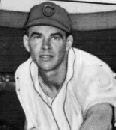
Hatten
Team Highlights
8-8-33: Roman (Lefty) Bertrand of Crookston pitched a 2-0 no-hitter over Fargo-Moorhead for the first no-hitter in league history. Only 28 batters faced him and 2 reached first base - one on a walk and one on an error. Bertrand struck out 8 in his 7thstraight win. It was Lefty's first year in pro ball having been born in Cobden, MN. He did have past pitching experience with the Sioux City, IA, Stockyards team.
4-34: Crookston, under the helm of Lute Boone, "never gives the league any worry." Boone said he never found more baseball spirit than was in evidence at Crookston since he helped win pennants in St. Paul. Recently, the city's ballpark had a covered grandstand built and they fenced in the field and stands. .
8-35: Crookston was in the process of adding lights to their park from the Giant Manufacturing Company.
Crookston tested their new lighting system during an exhibition game vs the House of David team. After a loan is paid-in-full, the equipment will be the property of the city's park board and be used for all sports.
8-26-35: The first scheduled night game in the history of the league was played at Crookston where the Pirates beat the Grand Forks Colts 4-3. Highlights included "brilliant" outfield catches.
3-36: The Crookston president was E. E. Turnquist who announced a working agreement with the St. Paul Saints.
4-37: During their 1,100 mile bus trip to Crookston from their training camp Springfield, MO, the Pirates' bus caught fire. All players escaped injury which occurred when the team was only 8 miles out from their training camp. However, some of the players lost their personal belongings. On the baseball front, there did not seem to be much optimism around the club as only 2 veterans from last year's club returned for 1937.
4-38: Crookston formed a working agreement with the Minneapolis Millers.
5-39: Crookston's park was listed with lights of 150,000 watts, dimensions of 323, 450, 299 and a 1,500 capacity.
5-31-39. Former major-leaguer Phil Todt was released by Crookston. He was signed to be a playing manager, but club officials claimed it was difficult to get him to even make a personal appearance on the field.
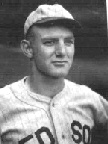
Todt
6-39: Arve Montrude was named permanent manager at Crookston. He had become the acting manager when Phil Todt was fired.
7-41: Ade Stemig became the manager at Crookston succeeding Ray
Oppegaard. It was described as an "economy move" by the
team's board of directors. Stemig played in the league from it's
origin in 1933.
Winter 1941-1942: The Crookston franchise was
moved to Sioux Falls, SD, and became the "Canaries".
Crookston
club's officers:
1940: D.A. McKenzie, president
1941: Judge Murphy, president
Grand Forks, ND, (pop. approx 17,300) and East Grand Forks , ND, (pop.? 5,000) each had teams in 1933. The East team ("Colts") only lasted the one season with a sixth place finish. Thereafter, both cities supported the Grand Forks "Chiefs". During the first few years, games were played in a East Grand Forks park where ground rules were required because of a short left field fence. Later a fine municipal park was built in Grand Forks. Johnny Anderson became the manager and GM, but he thought attendance should be better and moved the club to Jamestown, ND (pop approx 8,000)for the 1936 and 1937 seasons (.515 combined winning percentage and a first place finish in '36). Their attendance was worse then ever and the franchise returned to Grand Forks in 1938. Eventually, Anderson encountered severe financial problems and the team was purchased by an organization of businessmen.
The Chiefs operated for 26 years until 1964 with a .451 win/loss
percentage. They finished first three times and had four playoff
championships. Their managers included Johnny Mostil, Larry
Bettencourt, Bruno Haas, Bob Clear and Tom Saffell. Former players
who reached the Big Show include Willie Stargell, Gene Alley, Ed
Bauta, Don Bosch, Donn Clendenon, Jim Dickson, Phil Haugstad, Morrie
Martin, Orlando McFarlane, Gene Michael, Jimmy Price, Howie Schultz
and Dave Wickersham. They were associated with the White Sox from
1939-42, the Dodgers in 1946, the Yankees from 1948-50, the Phillies
from 1951-52, the Pirates from1956-62, the Indians in 1963 and the
Dodgers in 1964.
Stargell
Their Municipal ball park was built in 1938 as a WPA project at the corner of 5th Avenue South and Washington Street. It was demolished in 1965 and is currently the site of Xcel Energy and the 1124 Demers Ave. Fire Station.
.
[To see a photo of a scale model of the Chiefs' ball park, you may visit the website: http://www.digitalballparks.com/ ]
Team highlights:
4-33: Grand Forks owner, Russell Voelz, moved his franchise across the Red River to East Grand Forks, MN. The move was made when business men of East Grand Forks offered to construct a new grandstand and turn the city ball park over to Voelz. A suitable park could not be provided in Grand Forks.
7-3-33: John Anderson was released as the East Grand Forks manager and was replaced by John Vanusek. Anderson then bought the controlling interest in the team, became the club president and named himself manager again.
4-34: Grand Forks owner/manager Johnny Anderson stated that the city's business men gave him the "required support."
4-35: Grand Forks reached an agreement with Davenport (Western) that would provide players for the newly-named "Chiefs". Six players were sent to GF during training camp. Davenport will have their choice of Chiefs' players at the end of the year.
Winter 1935-36: During the off-season, the Grand Forks franchise was transferred to Jamestown, ND. The plan was for part of the club's schedule to be played in Greater Grand Forks. It was reported that Jamestown business men and civic organizations had formed a Boosters' Club with the help of owner/manager John Anderson. The city had not had an pro team since the Dakota League folded in 1922.
7-7-36: The first night game was played at Jamestown [an exhibition?]. A 100,000 watts lighting system was purchased through the co-operation of the park board, the chamber of commerce, Jamestown College and the junior chamber of commerce.
Mid-July, 1936: Johnny Anderson who had been the owner and manager at Grand Forks and Jamestown, sold his interest in the Jimmies' franchise to a group of Jamestown business men. He also quit as manager and was replaced temporary by shortstop Ernie Olson and later (permanently) by George Foster who was originally of Joplin, MO. For the past two years Foster had resided in Jamestown and had been a member of the town's semi-pro team. He had also played on town ball teams, since he was 16-years-old, in Joplin, Tulsa, and Fullerton, CA. Foster had never previously played professionally. Another report indicated that businessmen from Valley City, ND, also bought interest in the team with the understanding that part of the team's schedule would be played in their city.
8-36: The ownership of the Jamestown franchise was passed to the Jamestown Baseball Club, Inc. The team officers were: A.J. Breitback, president; Dr. J.D. Carr, vice president and John Bernabucci, secretary-treasurer. Stock in the team was sold locally.
9-36: Jamestown won the league pennant with a 73-50 record which was 4 games ahead of Eau Claire (67-52).
6-5-37: The owner of the Jamestown team, A.J. Breitbach announced that he was negotiating with Ray Doan, of Muscatine, IA, to sell the franchise. The report seemed to indicate that if Jamestown were not be in the Northern League in 1938, they would be part of a new a 6-team N.D. circuit.
Mid June, 1937: League President Herman White declared his opposition to the transfer of the Jamestown club. Ray Doan claimed he had been offered the franchise for free as long as the team remained in Jamestown, but he refused the offer.
Late June, 1937: The Jamestown franchise played a series of home games at Bismarck, ND, in order to determine if the capital city had a sufficient fan base to support it's bid for the team.
8-4-37: The Jamestown franchise was turned over to the league and they played the remainder of the season's games on the road. Former club president A.J. Breitbach said it had to be done because of "lack of support by the fans." Salaries of the players were to be paid by the league and Ken Penner, who had recently been manager at Montgomery (Southeastern) was placed in charge of the team. He replaced Mike Kash who had taken over from Eddie Kraus a month before.
4-38: Grand Forks returned to the league two years after their franchise was moved to Jamestown.
6-14-38: The first game was played at Grand Forks' new lighted ballpark which had a seating capacity of 1,200. The Chiefs had been using the old East Grand Forks field while the new one was being completed.
5-39: Grand Forks' ball field had lights totaling 150,000 watts and had 323, 458, 323 dimensions for a 2,500 seating capacity.
6-17-39: George Shoenecker of Grand Forks pitched a 1-0 eleven inning no-hitter against Crookston and Joe Hatten. Only 2 Pirates' runners reached base - both on errors (one on an overthrew in the 1st inning and the other when Shoenecker misplayed an easy ground ball in the 10th). He did not walk anyone. Hatten only gave up 6 hits and lost the game in the 11thwhen the Chiefs got 2 hits and the Pirates committed an error for the game's only run. In the game, Shoenecker extended his scoreless innings streak to 30 2/3.
7-20-40: Karl Wolfberger of Grand Forks pitched a 3-0 no-hitter against Superior. The righthander struck out 13.
9-8-40: Grand Forks won their first league pennant with a 79-44 record. They finished 9 ½ games in front of Winnipeg (66-52).
9-40: The victors in the playoffs' finals were Grand Forks who beat Winnipeg 4 games to 2.
4-41: Grand Forks announced that their new manager would be Larry
Bettencourt who was originally from New Orleans and was a football
star at St. Mary's University in California. He had played major
league baseball with the St. Louis Browns and managed at Springfield,
MA (Eastern) in 1940. Bettencourt was at spring training, this year,
with the St. Paul Saints and it was determined that he would be a
playing manager. Former Chiefs' manager, Pap Williams, was sold to
Winnipeg in the pre-season. 
Bettencourt
6-7-46: Pete Chapman resigned
as manager at Grand Forks. He was, by trade, an outfielder but had
been attempting to play second and third base for the Chiefs. Also,
he had not been hitting and his club was in last place. The Chiefs'
management choose Rae Blaemire as his replacement. Blaemire had
formerly been a major league and American Association catcher.
1946 - Grand Forks drew a record attendance for their franchise with 57,482 paid. It was 22,930 more then the previous record.
3-47: Claude Jonnard became manager of the Grand Forks Chiefs. He had pitched for the Tigers, Giants, Browns, A's, Cubs and many minor league teams. He was the twin brother of Bubber Jonnard who was an ex-Giant coach. Claude formerly managed in Shreveport, Joplin and Amarillo and had also scouted for the Giants.
6-4-47: The Claude Jonnard-led Grand Forks Chiefs lost their 20th game in a row. The team was the only independently operated league club in the league for 1947. The Chiefs had only won 3 games and were 10 games behind 7th place St. Cloud which was managed by Dave Bancroft. Dave was a teammate of Jonnard's on New York Giants teams in the early 1920s.
6-5-47: Grand Forks ended their losing streak at 21 games when they beat Eau Claire 8-5. It was the first victory for the Chiefs since May 17. During the streak they had been outscored 231-76.
8-7-48: Toby Tobias of Grand Forks pitched a 1-0 no-hitter against Eau Claire in a pitcher's duel with the Bears' Clarence Peters. The winning run scored with 2 out in the bottom of the 9th inning when Charlie Pickett singled in Wally Reed from 2nd base. It was only the 5th hit given up by Peters. Eau Claire got only one ball out of the infield - a 2nd inning fly by Lou Tufano. Tobias struck out 8, walked 6 and, at one point, pitched out of a bases loaded situation.
8-17-48: Toby Tobias pitched another no-hitter (10-0) over Duluth. The 22-year-old rookie righthander from Ellsworth, WI, again allowed only one ball to leave the infield when Milt Boyat hit a lazy fly to left field in the 3rd inning. The Dukes had 6 base runners - 3 by walks, 2 from errors and one hit batsman. Tobias struck out 11 and many were from his sharp curve away. It was his 4thshutout of the year and he also had two 3-hitters. He was signed in August 1947 by Yankees' scout Joe McDermott at a tryout camp in Hastings, MN. In high school, he played shortstop until 1941when he became a pitcher for 2 years before entering military service. The no-hitters were not made in consecutive appearances as, in games between the no-nos, he pitched a 14-8 victory and had a brief relief appearance to save a 10-inning 2-1 win for the Chiefs.
9-6-48: Grand Forks won the league pennant with an 80-39 record which was 1 ½ games better then St. Cloud (78-40). Entering the last day tied with the Chiefs, the Rox lost an afternoon game to Eau Claire and the Chiefs swept a double header over F-M. St. Cloud's night game was rained out. Duluth finished in 5th with a 53-61 record. In league history, to that point, there were only 2 pennant finishes that were closer - 1939 and 1942.
In the final playoff series, first place finisher Grand Forks beat the 4th place Aberdeen 4 games to 0. Chiefs' fans called it the "Rags to Riches" season since they finished in last place (55 games out) in 1947 and then won it all in 1948 by gaining the lead the first week of the season and never losing it. The clinching playoff victory, a 3-hit 2-1 win, was pitched by their ace, Milt Goemer.
1948: The team drew their largest season attendance of 71, 139.
7-20-49: Grand Forks manager Ed Kearse resigned. He was replaced by former major league outfielder Wally Berger. Berger had played with the Braves, Red and Giants and had been managing at Manchester (New England) until recently.

Berger
5-6-50: Grand Forks manager Jack Farmer died. It was described as "sudden". Second baseman, Wally Reed, was named temporary manager. The Chiefs had not played any games with Farmer as their skipper.
5-13-50: Grand Forks played their first game of the 1950 season with a contest at Duluth. The Chiefs' ball park was under water because of flooding by the Red River and temporary manager Wally Reed had been replaced by scout Dutch Zwilling who filled in only until permanent manager, Cedric Durst, could join the team. Durst, a former major league outfielder, managed at Omaha in 1949. On their way to Duluth, the team bus broke down at Romer (?). The Dukes' manager Russ Rolandson came to the rescue with their team bus to bring the beleaguered Grand Forks club to Wade Stadium. The Chiefs lost the game 6-5.
5-18-50: Grand Forks was finally able to stage their home opener. It was the first game for new manager Cedric Durst and they welcomed him by walloping Eau Claire 15-3. Chiefs' pitcher Mike Schultz only allowed 4 hits.
7-16-50: Richard Chrichton of Grand Forks pitched a 2-0 seven-inning no-hitter over St. Cloud. It was the first game of a double header and, in the 2ndgame, Bill Bethel throw a 2-hit 9-2 win for the Chiefs.
3-51: There were questions over the winter if Grand Forks would be able to field a team in 1951 after the Yankees dropped them as an affiliate. However, in February, the Chiefs were able to sign with the Philadelphia Phillies.
8-51: Joe Holte, who was president of the Grand Forks team since 1938, announced that he would not continue in that post for 1952. He had also "retired" in 1942 but was called back in 1946 when the league resumed operations after the war.
9-3-51: At the close of the season, Eau Claire (77-44) had won the pennant by 12 games ahead of St. Cloud (64-55).
9-51: Grand Forks won it's 3rd league playoff crown by winning 2 straight over Eau Claire 21-1 and 24-10.
5-52: Grand Forks won the Jim Stout Trophy which was awarded to
the city that had the largest crowd per capita on opening day. Grand
Forks drew 2,864. Superior had 2,867 and F-M drew only 1,916.
6-24-53: Grand Forks manager Carl Hosler was dismissed. It
was his first season as the pilot of the Chiefs. He had played in the
league with St. Cloud, Fargo-Moorhead and Duluth. His temporary
replacement was catcher Frank Calo.
6-10-54: Grand Forks fired manager Virl Minnis and replaced him with Frank Calo who had managed them the last 2 months of 1953 and had recently returned as a player.
6-29-54: Chester Dickey of Grand Forks pitched a 2-0 seven inning no-hitter over St. Cloud.
7-1-55: Johnny Hopp resigned as manager of the Grand Forks Chiefs and was replaced temporarily by Joe McDermott who was a Yankees scout and "trouble-shooter".
7-17-55: Ray Fletcher was named manager at Grand Forks. The 30-year-old catcher was formerly property of the White Sox who drafted him from Milwaukee (AA) in the winter of 1947, but he did not make the Sox. He had left pro baseball in 1952 and most recently was playing for Huron, SD, in the semi-pro Basin League.
7-4-57: Jack Paepke was named the new manager of the Grand Forks Chiefs replacing Al Kubski. Paepke was the manager of Jamestown in the NYP League when the team folded recently. He was expected to also be an active catcher.
6-30-58: Octavio Acosta of Grand Forks pitched a 12-1 no-hitter over Winnipeg.
8-16-58: A fund raising TV variety show was telecast in Grand
Forks in an attempt to provide money for the club to erase their
$5,000 operating deficit. For each dollar raised, the team gave out a
ticket to their August 25 contest. The main reason for the attendance
slump were the 10 rained-out games in 1958
5-17-62: Grand
Forks Municipal Park was damaged considerably by winds clocked as
high as 73 mph. The roof on the visiting team's dugout was blown off.
Approximately 100 feet of metal fencing on the north side of the park
was torn down and one section of the wooden right field foul line
fence was demolished. The damage occurred early in the day and that
day's game was played as scheduled.
9-62: Regular season champ Grand Forks ended the season with a 72-52 record which was 3 games ahead of D-S (69-55).
9-63: Grand Forks, with a 17-11 record. won the Baukol playoffs by 1 game over D-S.
1965 - The league lost one of it's oldest member, Grand Forks, their team with the best attendance, Winnipeg, and the Bismarck-Mandan club.
Grand Forks club's officers:
1938-42 and 1946-51: Joe Holte, president
1952: W.A. Holt [?], president
1953: Parm Lystad, president
1954: Ed Shields, president and Holte, bus. mang.
1955: Hilary Wilson, president and Holte, bus. mang.
1956: Holte, bus. mang
1957-61: Brooks Bankol, president and Holte, bus. mang
1962-63: A.C. Moore, president and Holte, bus. mang.
1964: Ralph Roth, president and Ron McWain, bus. mang. 
Fargo, ND (pop. 29,300), and Moorhead, MN (pop. ? 10,000), business people operated a combined team known as the "Twins". During the first two seasons, there was such dissension between groups from both cities that after the 1935 season, both factions agreed to turn management of the club over to Steve Gorman of Fargo. Originally, games were played in Moorhead where the 1913-16 Northern League had played. In 1936, Barnett Field was built in Fargo which was named after Fargo attorney and judge W.H. Barnett. The field and grandstand were built by the Works Progress Administration which supplied the labor with local businesses providing funds for materials. The first games were played on the field in 1936 but the official dedication was held on July 29, 1937. The field stood at the northwest corner of the old fairgrounds (19th Avenue and Broadway) and the final "Twins" game was played there on September 3, 1960. The park remained abandoned until 1963 when it was demolished and North High School was built there.
The franchise moved to Bismarck, ND in 1962.
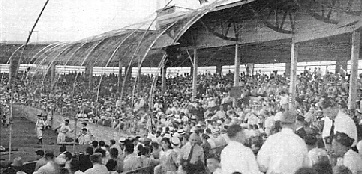
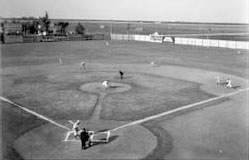
Barnett Field
The Twins operated for 25 seasons (.498 win/loss record) with
three first place finishes and four playoff championships. Managers
included Bruno Haas, Art Doll, Nick Cullop, Zeke Bonura, Tom Oliver,
Ken Silvestri and Dee Phillips. Fargo-Moorhead alumni who played in
the majors include Roger Maris, Bob Allen, George Banks, Horace
Clarke, Bill Dailey, Mudcat Grant, Steve Gromek, Wynn Hawkins, Don
Lock, Ray Mack, Pete Mikkelsen, Joe Pepitone, Jim Perry, Ken Retzer,
Dick Stigman, Bob Sturgeon, Willie Tasby, Ron Taylor, Ben Tincup,
Dooley Womack and Bill Zuber. 
Maris
Their major league affiliations were with the Indians from
1934-40, the Pirates from 1947-48, the Indians from 1954-57 and the
Yankees from 1958-60.
Franchise Highlights:
4-33: Fargo-Moorhead was owned by Al Theis.
6-33: Fargo-Moorhead, who had been in last place since the beginning of the season, threatened to pull into 6th place with their better play. However, original owner Al Theis sold the club to Ralph Williams who played third base for the team and was a former House of David performer. Williams made several positive changes to the club.
9-34: The Twins won the playoff championship with a 10-2 victory in game 6. They took the lead in the 1st inning and added to it throughout the game. Herm Crompton led the Twins' attack with 3 singles and a double and Bill Zuber pitched a 5-hitter.
3-36: The Fargo-Moorhead board of directors voted to accept an offer from the Zanesville (Middle Atlantic) club to finance the Twins in 1936 which would include construction of a new ball park in Fargo. The team operations were to be run by Steve Gorman and Jack Knight would return as manager. At the end of the season, the franchise ownership would revert to the people of Fargo and Moorhead.
8-36: F-M home games were played at Moorhead's League Park in August because of delays in completing work on Barnett Field in Fargo.
9-16-36: The first former Northern League player appeared in a major league game - Indians' pitcher Bill Zuber.
7-29-37: The new park at Fargo was formally dedicated and 3,800 fans turned out for the ceremonies and a 5-2 Twins win over Winnipeg.
5-31-38: F-M finally initiated the lights at Barnett Field with a crowd of 1,800 for a game against Winnipeg which they won 8-4.
5-39: The Fargo-Moorhead park had lights listed as 174,000 watts and their field dimensions were 326, 375, 320. The park's seating capacity was 4,000.
6-27-39: Fargo-Moorhead's manager, Jack Knight, resigned because of "ill health". There were also rumors of friction between he and his players. After the 1935 season, he also had left baseball because of the same "ill health." After the Twins moved to Fargo from Moorhead in 1937, he returned as manager. Knight also managed the team in 1934 and 1935. The team's new manager was catcher Chet Bujace who has played in the league since it's initial year of 1933.
8-14-39: Fargo-Moorhead attendance records were broken as the Twins drew 3,053. Then, on Aug. 15, they again broke the record with a 3,305 attendance. It was the 4th highest figure in league history.
7-1-40: Chet Bujace was relieved of his manager's duties for Fargo-Moorhead and was replaced by Wes Griffin who was a former pilot at Indianapolis (Amer. Assoc.). Bujace remained with the team as a catcher.
7-23-40: Fargo-Moorhead pitcher Del Leslie threw a 3-0 seven inning no-hitter over Eau Claire in the 2ndgame of a double header. Only 2 Bears' batters reached first base - one on an error and one from a walk. Leslie pitched for the first time in 5 weeks as he had been recovering from an injury.
Late June, 1941: Wes Griffin was relieved of his managerial position with Fargo-Moorhead. In what was described as an economy move, he was replaced by the team's catcher Mike Blazo. However, the Twins were in last place at the time of the move. Blazo had been purchased from Cedar Rapids (Three-I) in the spring.
8-5-41: Fargo-Moorhead pitcher James Schantel pitched a 10-0 no-hitter over Grand Forks. Twenty-nine batters faced Schantel in only his 2ndpro start. He struck out 4 and was aided by his club's good defense.
8-18-41: F-M held an "Out of the Red Week" in an attempt
to have the club break even financially for the year. It drew 8,224
paid admissions which was 224 over their goal. The goal for the
season was 30,000 but they did not have a chance to meet that mark
because of all of the bad weather in Fargo.
8-4-42: Ben
Tincup became the manager at F-M replacing catcher Mike Blazo. Tincup
was a former National League and American Association pitcher, a
coach for the Brooklyn Dodgers and a manager at Paducah (Kitty) until
that league recently stopped operations.
5-20-46: Fargo-Moorhead had the biggest opening day crowd with 4,040. They also won the league trophy for having the highest percentage of fans based on population (9.6%). Grand Forks was 2nd at 8.6 %.
Late May, 1946: F-M drew 22,164 in their first home stand which was not too much less then their complete season tally in 1942 of 26,313.
6-1-47: F-M players Tony Hussey, John Ciervan and Bob Ball were overcome by carbon monoxide on the Twins' team bus during their commute to Duluth. The exhaust pipe, on the bus, caused the problem. The game, scheduled for the same day, was postponed as the players were hospitalized briefly.
6-5-48: Bruno Haas was relieved as manager of the Fargo-Moorhead Twins who were struggling to stay out of last place after losing 22 of their last 27 games. The new manager was Ralph DiLullo who was a former catcher and had managed at York (Inter State). Haas was one of the last of the league's pioneers still active with the circuit.
7-22-48: Fargo-Moorhead President Steve Gorman announced that he would resign at the end of the season because the job took too much of his time.
9-49: F-M, who was the only league team that operated independently in 1949, agreed to a working agreement for 1950 with the Detroit Tigers.
6-22-50: A section of the outfield fence at Fargo was blown down by winds gusting up to 76 miles per hour.
5-3-51: At Fargo, 8,044 paying fans attended their opening game against Aberdeen (another 1,000 children were admitted free). It was a record for a class "C" league and was the product of much work by the new Twins' general manager Jack O'Connor. In the pre-season, a drive spearheaded by Jake Mauer and Cliff Stadum sold 5,000 advance ticket by April 18. The executive vice president of the club, Loren Oliver, also launched a face lift for Barnett Field. They added modern bathroom facilities, a new fence, re-roofed the grandstand and completed many other minor repairs which would have cost an estimated $18,000 to $20,000. Most of the actual work was done by volunteer architects, construction workers, plumbers, painters and just plain fans. Most of the materials were donated. "If a fan couldn't contribute material or money to his campaign, he volunteered his free time and often they worked until late in the night," said O'Connor. Fargo also purchased additional bleachers that seated 3,200 from a local college. Still, over 1,000 fans had to stand during the game.
5-31-52: Fargo-Moorhead manager Nick Cullop resigned. He had managed in the minors since 1941 at places such as Columbus, Milwaukee and Baltimore. The Twins were in a 3-way tie for 6th when he quit. It was reported that he drew his full year's salary at the time of his resignation. He was replaced by shortstop Bob Harmon.

Cullop
5-6-53: A crowd of 10,213, one of
the largest opening day turnouts ever to witness a class C game,
jammed Barnett Field in Fargo to see the Twins begin their 1953
campaign with a 12-3 victory over Sioux Falls.
Fargo-Moorhead's final record was 86-39 which was 13 games over Duluth. Santo Luberto won the batting crown with an .361 average. Ray Seif (F-M) had a 2.52 ERA to lead the league and won 20 games. Don Nace (F-M) also won 20 games
In the playoffs, the Twins beat St. Cloud and Duluth defeated Aberdeen 2 games to 0 games. F-M won the finals 3 games to 2 games.
1953: For the year, the team had their largest attendance of 108,210.
9-4-54: Frank Gravino was named the league's MVP for the 2nd straight year.

Gravino
9-6-54: Final standings showed Fargo Moorhead (85-55) finishing 4 games ahead of second-place St. Cloud (76-54).
9-54: In the playoff finals, F-M beat Eau Claire 3 games to 0.
5-4-55: A severe windstorm in Fargo blew down the center field fence which forced the postponement of the Twins' game with Grand Forks.
Fargo-Moorhead GM, Jack O'Connor, told the club's board of directors that he may not return to the post in 1956 even though he has a contract to do so.
5-27-56: Fargo-Moorhead played their first Sunday night game in history, but lost to Aberdeen 12-11 before a crowd of only 689. North Dakota had banned Sunday night baseball until 1954.
6-28-56: The Fargo-Moorhead club started a 2-day ticket drive to raise $20,000 in order to finance the team the rest of the season.
5-3-57: Dave Tyriver of Fargo-Moorhead threw a 2-0 no-hitter over Winnipeg. The former American Legion Junior star from Oshkosh, WI, stuck out 10 and walked 2. The Twins committed 2 errors and had a wild pitch and passed ball. It was the first 9-inning no-hitter, in the league, since May 29, 1955.
6-20-57: The game between Fargo-Moorhead and Duluth-Superior at Barnett Field, was about to begin when a devastating tornado struck within 4 blocks of the ball park. White Sox manager Joe Hauser said it sounded like "16,000 airplanes all at once." "We were at the park, warming up for the game," he said, "we could see this thing (the funnel cloud) in the distance. It was about ten miles away when we first spotted it and it was coming fast. The Fargo-Moorhead club was kind enough to invite us over to it's clubhouse which is a concrete affair. But there's a fence about 15 feet high between the clubhouse and the grandstand and, as I headed for shelter I glanced at the fence. What do you think I saw? There were ten of my players sitting on that fence, watching the tornado. Yep, they were all wrapped up in watching it; they looked like guys watching a World's Series. Those kids didn't realize how dangerous it was. You could almost reach out and grab the funnel." Gene Fitzgerald, the sports editor of the Fargo Forum, left the park after the twister struck at 7:40 and found his home had been destroyed, but his 15-year-old son had escaped injury. Team president J.G. Halbeisen and GM Ken Blackman also lost their homes.
7-5-57: Fargo-Moorhead needed an average of 1,400 paid fans, per game, to break even financially in 1957.
7-8-57: Red Ruffing managed the Fargo-Moorhead club for one game when regular manager, Frank Tornay, was hit on the base of his skull by a ball before the game. Ruffing was in Fargo as the Cleveland Indians' trouble-shooter and had to gain the permission of Vern Benson, Winnipeg's manager, before he could manage the Twins. Tornay was examined at a hospital and returned to the park in the late innings to watch the game from the grandstand.
8-24-57: After 7 straight losses, Fargo-Moorhead's directors fired manager Frank Tornay and replaced him with GM Ken Blackman. Blackman had previously managed several teams including Duluth.
9-1-58: Bruce Swango, of Fargo-Moorhead, threw a 8-0 no-hitter over Minot. He walked 7 and struck out 5 and two other Mallard players reached on errors. He had been originally signed by the Orioles in May 1955 for $30,000 but was released before pitching in a game. In 1956, he signed with the Yankees as an outfielder and played in the Sooner State league hitting .224. In 1958, he again was a pitcher going 8-9 in the same league.
9-58: F-M beat the Rox in the final playoff series 2-1 to win the
playoffs. It was the 11th time in 19 years, that the
regular season champ failed to win the playoff championship. In game
one, St. Cloud won 7-2 on two homers by John Orsino and the 6-hit
pitching of Bob Bolin. F-M won game two 6-3 on good defense (3 double
plays) and Bruce Swango's so-so pitching (9 hits, 8 walks). The Twins
KOed Gaylord Perry in the 2ndinning. In the deciding game,
Duane Kinart threw a 3-hitter for F-M's 9-1 win. It was 1-1 in the
7th inning, when the Twins scored 8 times (only 1 was
earned) on 10 walks from 4 Rox' pitchers. 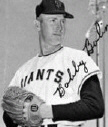
Bolin
8-12-59: Dooley Womack of Fargo-Moorhead pitched a 4-0 seven inning no-hitter against Minot.
6-4-60: The directors of Fargo-Moorhead gave up trying to find a new GM and divided the work load between four individuals: Don Rylance (paper), Steve Gorman (park supervisor), Betty Good and Walt Mabee (publicity and promotion).
Winter 1960-1961: The league was down to six teams with Minot and Fargo-Moorhead having dropped out.
Fargo-Moorhead club's officers:
1940-41 and 1946-48: Steve Gorman, president
1951: C.T. Tollefson, president
1952: Loren Oliver, president
1953-55: Oliver, president and Jack O'Connor, bus. mang.
1956: Oliver, president and Ken Blackman, bus. mang.
1957: J.G. Halbeison, president and Blackman, bus. mang.
1959: Lyle Myers, president and Marlys Davis, bus. mang.
1960: Myers, president and Virgil Watson, bus. mang.
-Little Falls, MN (7,000) franchise was operated and managed by Ray Mergens, a brother in law of Bruno Haas. The team was expected to draw well from lakeside vacationers but it did not and was moved to Brandon, Manitoba for the rest of the 1933 season. They returned to Brainerd for the 1934-1935 seasons. The franchise then was moved to Wausau, WI(23,000) for the 1936-1942 seasons. In Wausau, the team played at the old Wisconsin-Illinois league park until World War II when the city joined the Wisconsin State League. The Lumberjacks rejoined the Northern League for the 1956-57 seasons.
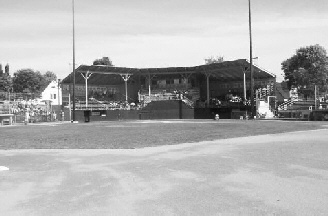
Wausau Park (current photo)
Over the nine seasons, Wausau had a .500 winning
percentage, had one first place finish and were managed by Lute
Boone, Dickie Kerr, Bunny Brief and Wally Gilbert. Players who made
the majors included Jack Baldschun, Ray Boone, Cliff Cook, Joe
Gaines, Jesse Gonder, Tony Gonzalez, Phil Masi, Vida Pinson, Elmer
Riddle and Cookie Rojas. Major league affiliations were with the
Indians in 1936 and 1942, the Phillies in 1940-41 and the Reds in
1956-57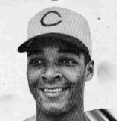
Pinson
Franchise Highlights:
4-33: Bunny Brief was delaying his start at managing Brainerd until he was sure his "filling" station business in Traverse City, MI, could do without him. Supposedly, Brainerd owner Mergens had a number of letters on his desk from other managerial possibilities. The owner was also attempting to form an all-rookie team to play at Bane Park from 200 potential players (letters received). Aspirants were to furnish their own baseball gear and pay their own expenses during the training period. It was reported that several Chicago youths were going by train to the training site which the city park board was getting in shape for the season.

Brief
Early June, 1933: The Brainerd franchise was transferred to Brandon, Man. Their first game was played there on this date after a 14-21 start in Brainerd.
Winter 1933-1934: Brandon, Manitoba, was dropped from the league because it's distance from the other league members increased expenses to too high of a level. However, Brandon itself made a profit. The franchise moved back to Brainerd.
3-36: Lute Boone, took over the Brainerd franchise and moved it to Wausau, WI.
5-11-36: Wausau became the 2nd league team to play some of their home games under the lights. It was reported that attendance at the night games that week "was encouraging."
7-13-38: Wausau pitcher Carl Lehman pitched a no-hitter over Fargo-Moorhead. He walked one batter and another runner reached base on an error. In 1935, Lehman had pitched a no-no for Tigerton High School.
5-39: Wausau's lights totaled 200,000 watts and the park dimensions were 321, 333, 312 with a capacity of 2,500.
9-7-41: Wausau won the regular season pennant with a 71-40 record which was 7 ½ games better then 2nd place Grand Forks (64-48).
3-42: Wally Gilbert was again signed to manage the Wausau
Lumberjacks for 1942. Team President R.J. Dudley also announced a
working agreement with the Cleveland Indians.
Gilbert
3-46: The Wausau and Winnipeg franchises did not survive the war.
St. Cloud, MN, took over the Wausau slot and Aberdeen, SD, the
Winnipeg one.
3-56: Superior gave up their franchise and
became part of a combined Duluth-Superior club. Wausau returned to
the league.
5-4-56: Wausau finally had their opener before 1,365 fans. However, the league only played 6 of it's scheduled games in the first week of the season because of bad weather.
1956: The club had their season record for attendance of 28,510.
7-18-57: Reports circulated that Wausau would move all of their home games to Pork Arthur, Ont. League President White said the reports were "without foundation" and Wausau President R.J. Dudley said that such a move had not even been discussed. Dudley stated he was optimistic that attendance would increase the rest of the season.
8-57: Wausau's board of directors were informed that $3,000 would be available from the major leagues' Stabilization Fund to cover a financial deficit if the Lumberjacks can finish the season.
Winter 1957-1958: Wausau withdrew from the league.
Wausau
club's officers:
1940-41: R.J. Dudley
1956: Norm Weaver, president and Dudley, bus. mang.
1957: Dudley, president
Eau Claire, WI (pop.
approx. 26,300) went against the odds to obtain league membership and
retain it for 27 years. Prior to the 1933 season, Johnny Mostil was
hired to manage and assemble players. He sent invitations to many
area players for a tryout camp. In addition, nearly 300 boys with
dreams also appeared. The team chosen, Mostil took the team to road
games in two seven passenger Studebakers previously owned by an
undertaker. They were located at "one end" of the league
with Grand Forks in the other - a distance of 550 miles. Many
financial problems ensued that first year and for months the players
played without pay. An Eau Claire business group kept them going
almost from game to game and the players were finally paid at the end
of the year. They also operated the next season on a shoe-string as
attendance gradually improved. The team's games were played at
Chappel Field on the north side of the city until the 1937 season at
which time Carson Park was built (and is still in use). The team
played in the league for 27 years.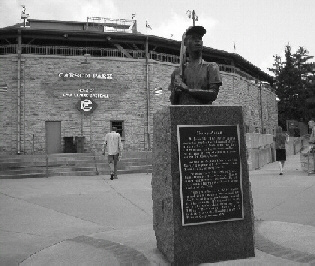
Carson Park entrance in 2004
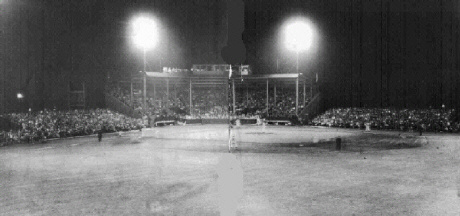
Carson Park in 1951
The "Cardinals", "Muskies", "Bears" and "Braves" compiled a .521 winning percentage during those years and finished first five times with three playoff championships. The teams were managed by the likes of Johnny Mostil, Rosy Ryan, Andy Cohen, Billy Adair, Charlie Root, Joe Just, Gordy Malzberger, Travis Jackson and Jim Fanning. Former players included Hank Aaron, Tommie Aaron, Bill Bruton, Rico Carty, Wes Covington, Jim Delsing, Hank Fischer, Patsy Gharrity, Manny Jimenez, Denny LeMaster, Lee Maye, Ron Piche, Bill Robinson, Stan Spence, Chuck Tanner, Joe Torre, Bob Uecker, Wes Westrum and Pete Whisenant.
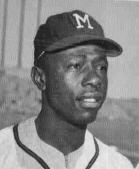
H. Aaron
Torre
They were affiliated with the Red Sox in 1936, the Cubs from
1937-39 and the Braves from 1947-62.
Team highlights:
4-33: Eau Claire was owned by David Quinn.
6-33: Regina, Saskatchewan, was bidding for the Eau Claire franchise and the Cardinals' owner Quinn threatened to move the team there. League President Voelz said that Quinn did not have the authority to make the move and the league would make "every effort to retain the club in Eau Claire."
6-33: League President Russell Voelz acquired control of the Eau Claire club from David Quinn. Voelz announced that the franchise would remain in Eau Claire and that a new grandstand would be built there.
Late July, 1933: The Eau Claire franchise was reorganized with Herman White becoming president and Johnny Mostil was retained as the manager. League President Russ Voelz severed his connections with the team, but initially kept the league's headquarters there. Later he moved the league's office to Minneapolis.
4-34: Eau Claire President Herman White reported that a grandstand was being built and four inches of good soil was being added to the loose sandy playing field.
5-36: A new park was being built in Eau Claire as a WPA project. The grandstand was constructed on concrete columns, reinforced with steel.
7-36: Building of the new park at Eau Claire was delayed by a shortage of material to complete the grandstand. The club gave up trying to play there that season.
9-36: In the playoff finals, Eau Claire won over Winnipeg 4 games to 3.
4-37: Eau Claire was scheduled to open their new $50,000 ball park with Gov. Phillip LaFollette attending. The park would have lights for night games beginning June 1. Club President Carl Bylander predicted that attendance, for '37, would increase to 40,000 for the season. Rain during 7 out of their 12 spring training days meant a slow start for the Bears. However, pitchers and catchers had indoor workouts at a local gymnasium.
5-4-37: The new park in Eau Claire had a record 3,000 fans for it's first game. The visiting Superior Blues won the game 7-5 with 4 runs in the 6thinning on 2 walks, a wild pitch, a sac fly, a balk and a triple by Ed Ficek. Einar Hoisve
got the win. Before the game, Gov. LaFollette made a short address stating "There is something in this world besides making money and right here you have an athletic layout that will serve the boys and girls of your city for generations to come."
8-29-37: The Chicago Cubs had an agreement to supply players to Eau Claire for the season
5-39: Eau Claire's lights were at 175,000 watts, the dimensions were 335, 435, 380 with a 3,200 capacity.
3-41: It was announced that the manager of the Eau Claire Bears
would be Wilfred "Rosy" Ryan. He had retired from baseball
in 1936 when he left the Minneapolis Millers. This year, the Eau
Claire club would be operated by Mike Kelley who was his boss at
Minneapolis and he fulfilled Ryan's request to get back into the
game. Ryan had graduated from Holy Cross College and was with the New
York Giants from 1919-1925 and other American League teams until he
was sent to AAA in 1926 and pitched there for Toledo, Milwaukee and
the Millers. 
Ryan
9-41: Eau Claire won the playoffs finals 4 games to Duluth's 3 to
become the 1941 Northern League Playoff Champs
9-7-42: Eau
Claire (81-41) won the league's pennant. Winnipeg (74-38) finished
second 2 games behind. It was the Bears first regular season league
championship and it took until the last day of the season for them to
clinch it because both Eau Claire and Winnipeg played double headers.
4-46: Joe Skurski was chosen to manage the Eau Claire club. He had been to spring training with the Milwaukee Brewers but it was determined that he should take the helm of their Bears' farm team. Skurski had recently been released from the service after managing a team at Camp Grant (IL) for the past two years. He would also play in the outfield for Eau Claire.
9-5-49: The Andy Cohen-led Eau Claire (71-52) held on to beat Aberdeen (71-54) for the 1949 pennant by one game. Earl Bass hit a 3-run home run with 2 outs in the 9th inning to beat St. Cloud 3-1 in the clincher.

Cohen
1949: The team drew their highest season attendance of 100,996 fans.
8-29-52: Gordon Roach of Eau Claire pitched a 10-1 seven inning
no-hitter against Aberdeen. The 6'6" 220-pounder from Toronto
struck out 8 and walked 8. His wildness was the cause of the one run
the Pheasants scored in the 3rd inning.
[For more on
the 1952 season, please see the web page "Hank Aaron and the
1952 Eau Claire Bears"]
6-18-53: Eau Claire GM Rand Bezanson informed the team's fans that if attendance did not pick up the city may lose the team, which is in last place.
9-5-55: Final standings showed that Eau Claire (81-43) finished 3 ½ games ahead of St. Cloud (78-47). Winnipeg and Aberdeen were tied for third with 70-56 records.
7-11-56: Merchants' Night in Eau Claire brought out their largest crowd in 3 years. More then 3,500 fans saw the Braves lose to Fargo-Moorhead 5-4 when a 9th inning rally fell short. .
7-22-56: John Lutz of Eau Claire threw a 5-0 seven-inning no-hitter over Winnipeg. He walked 7 and struck out 10. The San Diego-native had returned to baseball this year after 2 years in military service. He also had pitched for Eau Claire in 1953.
9-1-56: The final standings showed Eau Claire (70-52) winning by 5 games over Winnipeg (63-55), 5 ½ ahead of Duluth-Superior and 7 over Aberdeen.
4-57: After receiving information from about 50 minor league teams, including those in the Northern League, Eau Claire team officials submitted a proposal to the city council for permission to sell beer at Carson Field during the season. The council agreed to the plan by a vote of 4-2. The team was attempting to find another source of revenue in order to finish "in the black for the first time in several years." The brew would be sold in paper cups at concession stands and not from venders throughout the park.
6-12-59: Eau Claire manager Travis Jackson collapsed while pitching batting practice. The next day he turned over his duties to Gordy Maltzberger who, at the time, was the roving pitching coach for Milwaukee organization. In 1958, Jackson also was forced to give up managing at Midland in the Sophomore League.

Jackson
6-24-59: Travis Jackson returned as the full-time manager of Eau
Claire.
6-61: Jack Branscom was appointed as an assistant to
Eau Claire GM (business manager) Fran von Schrader. Branscom was from
Kirksville, MO.
8-16-62: Eau Claire team president George (Pappy) Wojahn announced that the team had exhausted their financial resources and, unless attendance increases, losses approaching $10,000 will be incurred in the 1962 season. The Milwaukee Braves declined to advance any funds beyond what was agreed upon prior to the start of the season.
9-62: Eau Claire became playoff champions by beating Aberdeen 2 games to 0.
1963 - The league, which was now designed as "class A"
was back to six teams as Minot and Eau Claire dropped out.
Eau
Claire club's officers:
1940: Mel Larson, president
1946-50: Otis Linderman, president
1951-52: R.B. Bezanson, president
1953: Bezanson, president and Don Dicker, bus. mang.
1954: Bezanson, president and Ed Bastian, bus. mang.
1955: Bezanson, president and Dean Ewing, bus. mang.
1956-57: Bezanson, president and Norm Macht, bus. mang.
1958: Bezanson, president and Mike Davies, bus. mang.
1959: Bezanson, president and Bob Quinn, bus. mang.
1960: Leo Howard, president and Quinn, bus. mang.
1961: Howard, president and Fran Von Schrader, bus. mang.
1962: George Mojobo, president and Clell Buzzell, bus. mang.
The Other League Cities
The Aberdeen , SD (pop. 22,000), Pheasants began in 1946 at the height of minor league baseball popularity by being rewarded the Winnipeg franchise. They sought a working agreement with a major league team which is something that evaded many of the teams in the league. As the story goes, the owner of a local florist shop, Ben Siebrecht, and the team secretary Joe Flaten traveled to St. Louis with roses and chamber of commerce brochures in hand to visit the St. Louis Brown management. They got the Browns attention and the working agreement. Then they raised operating funds of $20,000 by selling stock to the public.
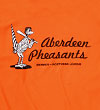
During the 1946, 1947 and 1948 seasons, average attendance was 70,000 a year and peaked at over 96,000 in 1949. Due to that strong gate, the team showed a profit each of their first four years. The 1950's began a new era as minor league attendance around the country dropped dramatically and 240 teams folded including two from the Northern League. As gate receipts dropped in Aberdeen, expenses rose and the club had a difficult time making ends meet. Between 1950 and 1958 the team was only profitable during the 1956 season. They did manage to break even in three of those years, but finished in the red in five. The Pheasants' board of directors took steps to lure fans back to the ball park. First, they lowered ticket prices and ran more promotions. Secondly, they created an emergency funding source in 1950 by organizing the Home Plate Club that was made up of Aberdonians who were willing to contribute up to $100 in the event of financial shortfalls. Thirdly, they decided the team needed a new parent club that would make a greater financial contribution. However, that major league team - the Browns - who became the Orioles in 1954, almost doubled their financial contribution to the team in order to continue their beneficial association. That increased contribution was part of an overall movement by the major league teams to save the minors and put the Pheasants back on stable financial ground for the 1960's.
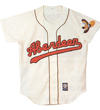
Other then the championship year of 1964, each year the team and the league faced more and more trials until time ran out in January 1972. However, through all of the Pheasants' 26 seasons the working agreement with the Browns/Orioles held fast. It became the longest continuous affiliation agreement between a minor league team and a major league organization.
Municipal Ball Park was originally constructed as a WPA project in
1936 and lights were added in June 1946. Based on the memories of
1958 Pheasant Gene Madaio, it was 350 feet down the left field line,
345' to right, 385' to center field and the right field power alley
was closer then the right field line. The park was demolished in 1975
for construction of Northern State University's Barnett Athletic
complex which houses a basketball arena, track and other athletic
facilities. 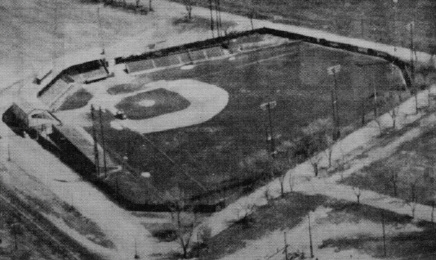
Aberdeen Municipal Park in 1950
The Pheasants achieved a .516 winning percentage winning two
regular season championships and three playoff crowns. Managers
included Don Heffner, Irv Hall, Brucie Ogrodowski, George Staller,
Billy DeMars, Earl Weaver, Cal Ripken Sr., Ray Ripplemeyer, Owen
Friend, Bill Werle and Ken Rowe. Former players included Jim Palmer,
Bob Bailor, Steve Barber, Mark Belanger, Bo Belinsky, Frank Bertaina,
Al Bumbry, Rich Goggins, Andy Etchebarren, Mike Fiore, Tito Francona,
Roger Freed, Bob Hale, Larry Harlow, Chuck Hinton, Dave Johnson,
Junior Kennedy, Darold Knowles, Don Larson, Dave Leonhard, Buster
Narum, Dave Nicholson, Tom Phoebus, Lou Piniella, Dave Skaggs, Herm
Starrette, Wes Stock, Bob Turley, Fred Valentine and Eddie Watt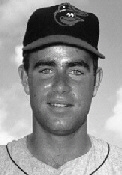
Palmer

Weaver

Ripken
[To see great photos of the old
Pheasants' ball park, you may visit the website:
http://www.digitalballparks.com/ ]
Team Highlights:
Winter 1945-46: The Wausau and Winnipeg franchises did not survive the war. St. Cloud, MN, took over the Wausau slot and Aberdeen, SD, the Winnipeg one.
4-46: The "parent "of Aberdeen club, the St. Louis Browns, announced that Gus Albright would be the manager of the Pheasants and Joe Flaten would be the business manager. Albright had recently returned from the Army where he was a lieutenant. In 1938 he was one of the youngest managers when he piloted Jonesboro.
9-1-47: In their second year in the Northern League, Aberdeen won their first pennant with an 82-36 record. In 2nd place was Sioux Falls (75-43) 6 ½ games behind. They also drew more fans then in any other season (90,156).
9-48: Aberdeen met Eau Claire in the playoff finals and won 4 games to Eau Claire's one. It was Aberdeen's first playoff championship.
6-26-49: Don Harris of Aberdeen lost a 3-1 six inning no-hitter against Fargo-Moorhead. Harris walked 7 and his defense gave up 2 unearned runs in the 6th inning. The game was halted by Fargo's Sunday curfew.
4-51: It was also reported that the Aberdeen franchise lost "heavily" in 1950, but businessmen in the city raised nearly $14,000 in a 2-week fund drive to provide capital to operate in 1951. This induced the Browns to continue their affiliation.
7-27-51: Aberdeen manager Joe King was fired with the Pheasants in 6th place. His temporary replacement was pitcher Jim Post.
8-3-51: The grandstands, portions of the bleachers and equipment of the Aberdeen Pheasants and of the visiting Grand Forks Chiefs were destroyed by an early morning fire at the Municipal ball park in Aberdeen. The grandstand burned to the ground, but most of the bleachers were saved and the lighting system had only minor damages. The cause was not immediately known. The grandstand held: "The Pheasant Inn - a $12,000 concessions stand, a dressing room, an office and rest rooms. Damage was estimated at $150,000 which included all of the Pheasants' baseball equipment except their road uniforms which were at the cleaners. Grand Forks lost all of their road uniforms, bats, gloves, shoes and other equipment. Aberdeen catcher Ernie Choukalos and a fireman were hospitalized. Choukalos was burned on his face and hands while attempting to save some of the team's equipment. It was reported that "The debris were cleared away before the last embers had died." Soon thereafter, "a caravan" of trucks and workman donated by local contractors began getting the park ready for resumption of the season. Mobridge, SD, offered to loan their portable outdoor bleachers to the club for the reminder of the season. It was thought that play could resume, at the park, on August 11.
8-23-51: Bruce Ogrodowski was named manager at Aberdeen. He was a former Cardinals catcher and, until recently, was manager at Wichita Falls (Big State). He took over from Jim Post.
5-17-52: Aberdeen held their home opener in the Pheasants' partially-refurbished ball park. They defeated Duluth 6-5.
8-26-52: Aberdeen set a club single-game attendance record as
2,671 fans paid for their final home game of the season. They also
broke their season record that had been set in 1948.
5-56:
Aberdeen won the opening-day attendance trophy with turnout of 2,631
based on the comparison of attendance to the city population.
7-12-56: Aberdeen unveiled a plaque, at their ball park, in the memory of their first team president, Ben Siebrecht.
8-7-56: Wind blew over a 3-pole light tower in Aberdeen just after the start of the game between the Pheasants and St. Cloud. The tower came down on the first-base bleachers which were, fortunately, unoccupied at that time. With rain falling, fans in that area had already moved to the grandstand for protection.
5-5-58: Aberdeen set a record for least number of paid admissions with 158. They had lost 6 in a row including games with scores of 22-2, 15-0 and 13-0.
5-19-58: The Aberdeen Pheasants ended their 18-game losing streak with a win 3-0 over Duluth-Superior. Bo Belinsky threw a 7-hitter and allowed only 2 walks.
5-58: It was reported that the Baltimore Orioles had planned to transfer Earl Weaver to Aberdeen to manage the last-place Pheasants. However, his current club (Dublin of the Georgia-Florida League) opposed the move and the Orioles backed off.
Manager Barney Lutz left the Aberdeen Pheasants to manage a rookie
league team in Bluefield, WV. This season was the fifth Aberdeen
managing stint for Lutz. Named to replace him was 32-year-old Billy
DeMars who played in two major league seasons for the A's in 1948 and
the Browns in 1951. Billy was known as a very good defensive
infielder (he won fielding awards in the International and Pacific
Coast Leagues), and was slated to play shortstop for the Pheasants.
DeMars had been recently released by Vancouver on the Pacific Coast
League to make room for some younger talent.
DeMars
8-24-58: Last place Aberdeen had a winning streak of 6 games. Attendance for the past two home games were 1,235 and 1,115. In the game vs Winnipeg, Steve Dalkowski allowed 3 hits, walked 13 and struck out 17.
[For more on the 1958 season, please see the web page "The 1958 Aberdeen Pheasants".]
5-17-59: Steve Dalkowski of Aberdeen threw a 6-0 no-hitter over Grand Forks. During the game, he struck out 21 batters to tie the 1939 league record of Joe Hatten. Dalkowski said he sensed that a no-hitter was a possibility in the 7thinning and "I got a bit shaky for a minute." He walked 2 batters in that inning and then retired the last 7 in order (6 by strike outs). During the game, he "only" walked 8 and the Pheasants committed one error. The Chiefs came close to a hit in the 8thinning when Ray Murawski hit a pop fly to short right-center, but Dave Nicholson made a diving catch. Dalkowski told reporters that he threw just one curve ball in the game "and it almost hit a batter so I quit using it." One of two Pheasants' catchers during the game, Dan Bishop, received a call after the game informing him that his first child, a girl, had been born.

Dalkowski
6-1-59: Aberdeen has drawn 15,245 fans in their first 18 games according to Promotion Manager J.D. Dulany. "With our 953 average to date," he said "it will take us only until July 18 to equal our gate for the entire 1958 season." The Sporting News had a contest ("Grand Sweepstakes Trophy"), at that time, for the first minor league team to exceed its previous season attendance total.
7-59: Aberdeen reached an attendance of 37,343 for 1958 to eclipse their 1958 total. In doing so, they won The Sporting News' Class C trophy in the minor leagues' attendance derby.
7-22-59: Dave Nicholson hit a home run in Wade Stadium, Duluth, which was measured at 500 after it had rolled to a stop. Unfortunately, rain ended the game before it became official and the homer did not count in the records. He hit two more long blasts in the other two games of the series.
8-8-59: A home run ball hit by Dave Nicholson was found a block
beyond the left-center field fence of Municipal Park in Aberdeen. He
had 22 home runs which was still 11 short of the club record set by
Dave Roberts, in 1954, of 33.
Nicholson
6-15-60: Jerry Alford of
Aberdeen pitched a 7-0 seven-inning no-hitter over Eau Claire.
Alford, 19, was a "bonus baby" signed off the campus of
Mississippi College. This was his second pro year.
8-24-61: After leading the league all season, Aberdeen (66-49) fell to 2nd place 1½ games behind D-S (65-47).
9-61: Aberdeen won the league playoffs by defeating St. Cloud in two successive games. It was the first playoff title for the Pheasants since 1949.
7-12-62: Mark Clarke of Aberdeen lost a 1-0 no-hitter against Grand Forks. Clarke, a 21-year-old former University of Arizona pitcher, struck out 7 and walked one. The Chiefs scored their run in the 4th inning when Dave Wissman was safe at first on an error. He was forced at 2ndby Vic Ramirez and then Ramirez stole 2ndand reached 3rdon a Dave Massarelli wild throw. He scored when Bill Barraclough's return throw bounced off third baseman's Phil Barth's glove.
5-28-63: Howard Stehers of Aberdeen threw a 6-0 seven-inning no-hitter against Grand Forks. In this his first start for the Pheasants, he struck out 6 and walked 2. Jim Rouse hit a grand slam to provide the necessary offense.
8-29-63: Dave Leonhard of Aberdeen pitched a 5-0 seven inning
no-hitter over Winnipeg. He walked 3 (Floyd Wicker in the 1st
and 4th innings and Coco LaBoy in the 7th).
Leonhard struck out 3.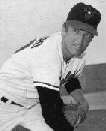
Leonhard
6-19-64: Jim Palmer of Aberdeen pitched a 8-0 no-hitter against Duluth-Superior at the Pheasants' park. The 18-year-old, who made his first start since May 8 due to a back injury, walked 9 and struck out 11. Palmer also homered to drive in 2 runs.
9-64: The final standings indicated Aberdeen (80-27) in first place by 12 games ahead of Grand Forks (69-50). The Pheasants also won the playoffs with an 18-9 record which was 2 ½ games better then Duluth-Superior (14-10).
Off-and-on, during the season, manager Cal Ripkin's son Cal Jr. was a team bat boy.
4-66: Aberdeen's continuing working agreement with the Orioles became the oldest agreement on record.. It began in 1946 when the O's were the Browns.
7-9-66: George Wolger of Aberdeen threw a 1-0 no-hitter over Huron. Wolger, a 19-year-old rookie, won a mound duel over Huron's Mike Beaver in the 1-0 game. George struck out 7, walked 2 and the Pheasants committed 2 errors. There were no hits even close to being a safety as only 2 balls were hit out of the infield. The Orioles had signed Wolger, who is from Redwood City, CA, in the spring of 1966 as a free agent.
8-20-70: The Aberdeen Pheasants and the Baltimore Orioles
celebrated the 25th anniversary of the longest consecutive
working agreement between a major league team and a minor league
affiliate. Frank Cashen (Ex. V.P.) , Harry Dalton (Dir. player
personal), Don Pries (Dir. player development) and Jim McLaughlin
(minor league business coordinator) represented the Orioles at a game
in Aberdeen.
Aberdeen club's officers:
1946-47: Ben Siebrecht, president
1948: Jim Stout, president
1950: Siebrecht, president
1951-52: Cy Kasper, president
1953: L.F. McMillan, president
1954: Pete Bradbury, president
1955-57: Bradbury, president and R.N. Kyburz, bus. mang.
1958: Kyburz, president
1959: B.J. McElliot, president an Pete McMillan, bus. mang.
1960: Olaf Mykleby, president and McMillan, bus. mang.
1961: Al Rylance, president and Stan Voas, bus. mang.
1962: Rylance, president
1963: Roland Parcel, president and Voas, bus. mang.
1964: Les Keller, president and Voas, bus. mang.
1965: Voas, president
1966: H.O. Schumacher, president Dennis Maloney, bus. mang.
1967: I.B. Christopersen, president and R.W. Brown, bus. mang.
1968: Neil Kleppin, president and Maloney, bus. mang.
1969: D.W. Angerhofer, president and Maloney, bus. mang.
1970: Brown, president and Harold Fowler, bus. mang.
1971: George May, president and Brown, bus. mang.

St. Cloud , MN,'s (pop.
21,000+) longevity in the league mirrored Aberdeen's, but they had
arguably more success on the field then any other Northern League
franchise. Their .531 winning percentage topped all of the long-term
teams in the league. They had a stable ownership, fan base and
playing facility (Rox Park was torn down for a Shopko store after the
league folded). Only their MLB working agreements fluctuated between
three different teams: the Giants in 1946 and 1948 through 1959, the
Cubs from 1960-64 and the Twins from 1965-71.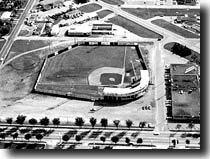
Rox Park
The Rox' eight first place finishes far exceeds the record of any
other franchise and they won two playoff series. Managers included
Charlie Fox (for eight years), Dave Bancroft, Joe Macko, George
Freese, Fred Martin, Jim Rantz, Ken Staples and Carroll Hardy. Former
Rox players include Gaylord Perry, Lou Brock, Orlando Cepeda, Matty
Alou, Bob Bolin, Steve Brye, Pete Burnside, Billy Cowan, Bob Gebhard,
Dave Goltz, Chuck Hartenstein, Ray Katt, Willie Kirkland, Craig
Kusick, George Mitterwald, Curt Motton, Jim Nettles, John Orsino,
Andre Rodgers, Mike Sadek, Jimmy Stewart, Tony Taylor, Danny
Thompson, Ozzie Virgil Sr. and Leon Wagner
Brock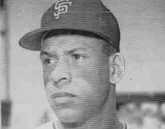
Cepeda
Fox
Team Highlights:
4-46: The Wausau and Winnipeg franchises did not survive the war. St. Cloud, MN, took over the Wausau slot and Aberdeen, SD, the Winnipeg one.
The St. Cloud city commission authorized about $40,000 for a new playing field and electric lights. Plans for a new grandstand there were delayed because of problems with local building regulations.
9-2-46: St. Cloud won the league' regular season pennant by finishing 73-31 which was 10 games ahead of Fargo-Moorhead (63-41).
9-46: In their first year as a member of the league, the St. Cloud Rox won the playoff finals 4 games to one over F-M.
3-47: Dave Bancroft was named manager of St. Cloud Rox. He first played pro ball at Superior in 1909 and spent nearly 30 years in baseball. He was quoted in "TSN": "The game now is not only faster than in those days, but the players, by the time they get into the lowest leagues, now know plenty of the inside of baseball. They learn this from American Legion play, from the various baseball schools and also technical publications. I couldn't make a full comparison of the game in 1909 and now. There is the matter of playing equipment and the fields themselves. You know, I never received a bit of constructive instruction on inside baseball until I reached the Phils in the National League in 1915...I wouldn't say that the fields in the old days were bad. But, at Superior's Hislop Park, the ball used to take some queer hops."

Bancroft
9-47: The St. Cloud city commission voted to accept bids for a $78,000 municipal ball park. The concrete park would seat 2,100. More then a year ago, the city voted bonds for the purpose of building the park and it was hoped that construction would begin in the fall.
5-48: Until the completion of their new ball park in St. Cloud, the Rox played their home games in the park at the Little Falls Fairgrounds, 30 miles north. The new park's construction was delayed by cold weather and flood conditions in the early spring.
6-23-48: From the "St. Cloud Daily Times": "Twenty five hundred fans as well as mayors of area towns, baseball dignitaries, Mayor Malisheski and Mayor Hubert Humphry of Minneapolis paid tribute to the people of St. Cloud and to the builders and promoters of the municipal sports field in special dedication ceremonies Friday night. Before a completely filled grandstand, speeches were made and music was played to delight a gala crowd that found everything to their liking except the score, which went 8-3 for Superior over the Rox. The Veterans of Foreign Wars Drum and Bugle corps, let by Genevieve Trundnaki, entertained during pre-game periods and throughout the stadium. Their exhibition of precision marching was accentuated by smart new uniforms which the girls wore. The St. Cloud Municipal band under the direction of Erin A. Mertz played a group of numbers including marches and waltzes and opened their program with 'Take Me Out to the Ball Game.' Rev. Alphonse Krammer gave the invocation followed by an introduction of Herman White of Eau Claire, president of the Northern league and chairman of the executive committee of the National Association of Professional Baseball leagues, who complimented the locals on the new stadium on behalf of the league. Don Merr, master of ceremonies, introduced Rosy Byan, general manager of the Minneapolis Millers who said that the patrons deserved considerable credit for patronizing the Rox team for two years with inadequate seating in the park. He stated that when the St. Cloud Baseball organizers came to Minneapolis for assistance, all they had was a franchise. 'You fans have justified the faith the organizers had in you,' he declared."
7-4-48: The president of the St. Cloud Rox, Joe Miller, died in St. Cloud after being hospitalized for several months with heart and kidney problems. He was one of the original organizers of the club.
9-4-48: Ken Vangilder of St. Cloud threw a 1-0 ten-inning no-hitter against Superior. He was the son of Elam Vangilder who was a former pitcher with Detroit and the St. Louis Browns. His feat was the first by any St. Cloud pitcher and placed the Rox in a tie for first place with Grand Forks. Vangilder, who had pitched at class B Trenton in 1947, dueled with the Blues' Joe Demoyan for 9 innings. However, the Rox got 3 of their 10 hits in the 10thwith the final one by Frank McArthur for the game winning RBI. He had 23 strikeouts and walked 4. Only 2 putouts were made in the outfield and one error was committed by each team. The Rox were helped by 3 double plays and 2 Blues reached 2ndbase.
1948: The club set their single season attendance record of 66,389.
5-7-50: A storm flooded Rox Park at St. Cloud and partially demolished their outfield fence.
9-10-50: St. Cloud (72-51) won the league pennant by only ½ game over Eau Claire (73-53) as they both lost their final game. If Eau Claire would have won the last game with Superior (they lost 7-6), they would have finished first. The Rox had lost their final contest 7-1 to Duluth.
5-29-55: John Zarcone of St. Cloud pitched a 13-0 no-hitter against Aberdeen. He walked 3 and struck out 7. This was the second pro season for the Long Island native.
7-27-55: Frank Funk of St. Cloud pitched a 1-0 seven-inning
perfect game against Superior. He struck out 4. Blues' pitchers, Rich
Ramos and Harold McGahey, nearly duplicated his effort by allowing
only one hit.
9-55: The playoff champion was St. Cloud as the
beat Eau Claire 3 games to one game.
7-31-56: Attendance was a concern at St. Cloud who drew only 25,082, including exhibition games, through July.
9-56: The New York Giants renewed their working agreement with St. Cloud and praised the officials of the club for showing "a great deal of poise and fortitude." The Giants' Jack Schwartz continued: "I want you to know that we have all been much impressed with the utter absence of weeping and moaning from St. Cloud in the face of a season that would have had many of our other affiliates hanging crepe all over themselves." The Rox finished in 6th place.
6-7-58: A station wagon carrying five St. Cloud Rox players overturned after the left-rear tire blew out. The vehicle was driving back to St. Cloud after a night game in Minot. All of the players, including John Orsino, escaped injury.
9-2-58: St. Cloud won the league championship with a 72-50 record which was only ½ game in front of F-M (72-51). The Rox were in 5th place on August 1, but won 40 of their final 46 games. On the final day of the season, they lost an afternoon game to Aberdeen 3-1 in 13 innings. In the evening contest for the pennant, they beat the Pheasants 5-3 due to the relief pitching of Gaylord Perry. He came into the game in the 8thinning with no outs and 2 men on base. Perry struck out 4 of the final 6 batters to get the save.

G. Perry
6-26-60: Morrie Stevens of St. Cloud pitched an 8-0 no-hitter over
Minot.
7-9-61: Franklin Hodges of St. Cloud threw a 1-0 seven
inning no-hitter against Aberdeen in the Hub City. Hodges, from
Dunham, KY, allowed two base runners - a hits batsman in the 5th
and by a walk in the 7th. He struck out 4
8-17-65: Ron Keller of St. Cloud pitched a 3-1 seven-inning no-hitter over Aberdeen. In the 5th inning, after hitting Pete Lewis in the face with a pitched ball, he walked 3 consecutive batters to loss his shut out. The former U. of Indiana pitcher from Indianapolis, then settled down to complete the no-no.
9-2-65: At the close of the season, St. Cloud (43-23) had a 12 games lead over Huron and D-S who both had 31-35 records. Aberdeen was 16 games back.
9-5-66: St. Cloud won the league championship with a 49-18 record which was 3 games in front of Aberdeen who had a 47-22 record. The third place team (Huron) was 17 games behind.
9-4-67: St. Cloud (44-26) won the league pennant by 7 games over Mankato (37-33) and 9 games better then Sioux Falls (35-33). It was the 3rdstraight championship for St. Cloud.
9-2-68: Needing a victory to win the league championship, St. Cloud manager Carroll Hardy started his ace, Dave Goltz against Duluth-Superior after the Rox had won 2 straight against the Dukes. But, Goltz gave up 4 runs in the first inning while getting only one out. In desperation, he turned the game over to Tom Ferraro who did the improbable - shut out the Dukes for 8 2/3 innings. The Rox scored 2 runs in the 6th and 3 in the 8th for a 5-4 victory and the league championship.
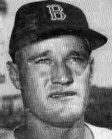
Hardy
9-4-71: The St. Cloud Rox (42-28) walked away with the league pennant by finishing 7 ½ games ahead of Aberdeen (35-36) and 8 ½ in front of Sioux Falls (34-37).
St. Cloud club's officers:
1946: Frank Murphy, president
1947-48: Joe Miller, president
1951: F.J. Bernick, president
1952: Murphy, president
1953-54: W.A. Daniel, president and Frank Farrington, bus. mang.
1955-57: P.L. Halenbeck, president and Jas Nierengarten, bus. mang.
1958-59: Hugo Weyrens, president and Nierengarten, bus. mang.
1960-61: Allen Heuerman, president and Karl Weiler, bus. mang.
1962: Clete Winter, president and Weiler, bus. mang.
1963: Winter, president and Sam Wenstrom, bus. mang.
1964: Pete Pfepson, president and Wenstrom, bus. mang.
1965: Eldon Witschen, president and Wenstrom, bus. mang.
1966-67: Pfepson, president and Wenstrom, bus. mang
1968: Chuck Albers, president and Wenstrom, bus. mang.
1969: Jim Gammel, president and Glen Carlson, bus. mang.
1970-71: Nick Chanaka, president and Carlson, bus. mang. ![]()
Sioux Falls , SD (pop. 35,000+) had a 15-year run, during two different time periods, playing in Old Howard Wood Field (a high school facility at Tenth Street and Cliff Ave. - later the location of a Sears store) until 1954 and the Sioux Falls Stadium (aka "Packer Stadium") which opened in 1964. It was necessary for the team to leave the league after the 1953 season because Old Wood did not warrant expensive improvements for modern lighting and seating. It also had a running track which caused numerous headaches during baseball games.

The Howard Wood Field grandstand in 1958 (Bob Feller was conducting a clinic)
From 1942 though 1953 they were known as the "Canaries"
and were a farm team of the Cubs and from 1966-71 the "Packers"
were associated with the Cincinnati Reds. Over those years, they had
a .487 win/loss percentage, never finished in first place, but won
two playoff championships. Managers included Lynn King, Jim Synder
(for four years) and Russ Nixon. Former players who became major
leaguers include Joaquin Andujor, Harry Bright, Darrel Chaney, Don
Elston, Ken Griffey Sr., Ross Grimsley, Don Gullet, Fred Kendall, Ray
Knight, Gene Locklear, Will McEnaney, Gary Nolan, Wayne Simpson, Lou
Sleater, Joel Youngblood and Pat Zachry.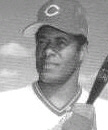
Griffey Sr.
Sioux Falls Stadium still exists but little of the original park is left as there were extensive renovations done in the late 1990's. These renovations included new luxury boxes, an expanded picnic area, and new grassy slops among other improvements.
[You can view the stadium in it's current form at:
http://www.ballparkreviews.com/siouxfalls/siouxfalls.htm
]
Franchise Highlights:
3-42: The Crookston franchise was moved to Sioux Falls, SD, and became the "Canaries". The South Dakota city, who formerly had a team in the Western League, was the first from that state to enter the league. . Entering the season, Sioux Falls was the only league club not to have an affiliation
5-8-42: A paid crowd of 1,300 attended Sioux Falls' inaugural league game vs Winnipeg. The Maroons scored 3 runs in the 9th inning to take a 13-5 lead, but the Canaries rallied with 5 runs and nearly pulled even. The final score was 13-10
5-14-42: The Winnipeg home opener was postponed because Sioux Falls' bus broke down due to engine trouble. The vehicle, which had climbed mountains and crossed burning prairies when the team was in the Western League, stopped at the Canadian border. The Canaries used other transportation to eventually reach Winnipeg and later picked up the bus with a new engine installed.
5-26-42: Sioux Falls sold tickets to their capacity of 3,500 on "Merchants Night". The Canaries defeated Superior 5-3.
7-16-42: Sioux Falls owner Rex Stucker announced that only 9,893 fans paid to see the Canaries play in their first 21 home games. When the team played in the Western League in 1941, attendance was 18,591 in the first 23 home contests.
7-20-42: Manager Joe Bosse of Sioux Falls resigned and was replaced by Mel Ivy who had recently been obtained from the disbanded Kitty League. Bosse said: "I'm not helping the club and my conscience won't let me take my present salary for running the team." The Canaries had lost 9-straight at the time of Bosse' resignation, but he stayed with the team as a player.
7-28-42: Sioux Falls changed managers again. After Mel Ivy was released, he was replaced by outfielder Lou Frierson who came from the Clovis club (West Texas-New Mex.) after they stopped play recently.
5-46: Ken Guenther was appointed the business manager of the Sioux Falls club. He was a former sports writer and had recently returned from Japan as a lieutenant colonel in the Army.
8-46: Sioux Falls manager Lynn King resigned. He was replaced by veteran catcher Tony Keonig who had formerly played on Sioux Falls teams in the Western League.
3-47: Sioux Falls reached agreement with the Chicago Cubs to be their farm club. They were scheduled to receive a manager and 10 players for the season as they become the Cubs' 19th affiliated minor league club
Jim Oglesby was named manager at Sioux Falls. He was a former first baseman for the Philadelphia A's and AAA's Kansas City and Los Angeles. He had not decided if he would attempt to play at age 42 or just be a bench manager.
9-14-47: The final series ended with Sioux Falls taking 4 games to Aberdeen's 2. The deciding game was won with the 5-hit pitching of Dick Verbic who won 2 games in the series for the Canaries. It was Sioux Falls first playoff victory.
1947: The team had their highest season attendance of 116,683 which was also a league record.
6-48: During the 1948 season Ken Guenthner, who was the president and general manager at Sioux Falls, also broadcast the team's games on radio. An ex-newspaperman, he did the play-by-play of both home and away games on station KIHO. Guenthner claimed that he could keep the broadcasts on an impersonal level - unless the Canaries began a rally.
9-50: In the final round of the playoffs, Sioux Falls beat Superior 4 games to one to win their 2nd league playoff championship.
8-13-52: Don Elston of Sioux Falls threw a 5-0 seven-inning
no-hitter over Grand Forks. Elston struck out 16 batters and
completed his 18th game in 1952. He was 15-6.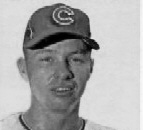
Elston
9-53: It was announced that
Winnipeg would return with a team in the league for 1954. They had
last fielded a team in 1942 and had acquired the Sioux Falls
franchise who had no available ball park after 1953.
6-56: Lead by Ossie Schock, several Sioux Falls businessmen
announced plans to build a privately-financed ball park to attract a
pro team . The city last had a Northern League club in 1953.
3-64:
A news report in the "Sporting News" stated that "work
was under way on a new park" in Sioux Falls. The Basin League
had been wanted to expand with a team in South Dakota's biggest city.
A new park would also make Sioux Falls a prime candidate for
re-admission to the Northern League.
1966 - The league regained former members Bismarck-Mandan and Sioux Falls to expand it's membership to six teams.
6-28-66: Sioux Fall returned to the league with an opening day crowd of 2,026. Packers' pitcher Bob Hall got the win in a 3-0 victory over Huron.
8-66: Sioux Falls renewed their working agreement with Cincinnati.
In the agreement, the Reds would pay the entire salaries of the
players and manager
Sioux Falls club's officers:
1946: Rex Stucker
1947-53: Ken Guenther, president
1966: K.O. Vesledahl, president and Bill Melody, bus. mang.
1967: Vesledahl, president
Bismarck , ND (population
25,000+)
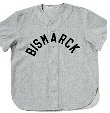
- Mandan, ND (pop. ? 5,000+) won a league franchise in 1962 and played through 1964 and again in 1966. They had an affiliation with the Minnesota Twins for their first three years and finished with the Astros in 1966. Future major league coach Vern Morgan managed the "Pards" their first three years. Their low attendance in 1966 set a league record for a short season. Their win/lost record, over the four years was a poor .404 and they never finished above third place.
Former players who reached the majors included Dave Boswell,Tom
Griffin, Rodric Harrison, Fred Lasher, Rudy May, Rich Reese, Scipio
Spinks, Fred Stanley and Wayne Twitchell.
The Pards played at
Municipal Ball Park which was destroyed by fire in 1972.
[You can view a picture of the park at:
http://www.digitalballparks.com/
]
Team highlights:
3-58: Bismarck-Mandan was scheduled to begin play in the Northern
League in 1958 as the polar circuit had planning to expand to 10
teams. However, with the withdrawal of Wausau and the addition of
Minot, the plan could not be completed. The league directors assured
B-M of active status for 1959 when they would be added with another
team (perhaps Sioux Falls) or replace a club already in the
league.
1962 - The league was back to 8 teams as Minot
returned and Bismarck-Mandan joined.
8-62: Bismarck-Mandan club president, Jack Hoeven, announced that attendance of 40,017 for 62 home games "proves that professional baseball has been a success in its first year in Bismarck-Mandan."
9-62: After the season, the Pard's Park was used for the "Little League World Series". The park was described in "The Sporting News" as "one of the finest in the country. Neatly kept, it measures 321 feet down the left field line, 320 along the right field line and 410 to straight away center field. An eight-foot-high board fence surrounds the outfield.
1962: The teams drew their franchise record of 37,786 fans.
1965 - The league lost one of it's oldest member, Grand Forks, their team with the best attendance, Winnipeg, and the Bismarck-Mandan club.
1966 - The league regained former members Bismarck-Mandan and Sioux Falls to expand it's membership to six teams.
1967 - Bismarck-Mandan left the league for the final time and were replaced by a club in Mankato.
Bismarck-Mandan club's officers:
1962: Jack Hoeven, president and Robert Moses, bus. mang.
1963: Roger Higgins, president and Connie Juelke, bus. mang.
1964: Higgins, president
1966: Gerald Just, president and John Danz, bus. mang.
Huron , SD a town of only 12,000 people entered the league in a big way by setting a short season attendance record of 44,000 in 1965. At one point, they ran out of tickets during a Spring advance ticket sale. However, the teams supplied by the Phillies (1966-68) and the Cubs (1969-70) were not the best. Over their six years, the win/loss percentage was only .452 and they had no championship teams.
Managers were Joe Lonnett, Dallas Green, Mel Wright and George
Freese. There were a number of very good individuals who played for
Huron and they include Bill Bonham, Billy Champion, Larry Cox, Toby
Harrah, Larry Hisle, Greg Luzinski, Dyar Miller, Rick Reuschel, Ken
Reynolds, Andre Thornton, Jim Todd, Matty Trillo and John Vikovich
Hisle
Huron played at below ground-level Memorial Park which was built in 1950 and still exists.
[To see a photos of Huron's ball park, you may visit the website:
http://www.digitalballparks.com/
]
Team highlights:
4-65: The club president of Huron, Jerry Bales, said the team had no difficulty selling $8,500 worth of stock. In addition, their ticket drive was so successful that the team ran out of ducats and had to reserve orders until a new supply arrived.. The Phillies offered a family season ticket for $10.
6-65: Huron won the opening day attendance trophy with a crowd of 2,544. Bands, cheerleaders, a dance act and nattily-attired usherettes added to the pleasant atmosphere. Throughout the game, fans shouted "Go, Phillies, Go", but it was for naught as the home team lost 4-3 when Aberdeen rallied for 3 runs in the 8th inning.
8-15-65: Ray Goodwin of Huron lost a 10-inning no-hitter to Duluth-Superior 1-0. The 19-year-old from Morristown, NJ, walked a batter and allowed 3 singles in the 11th. Huron batters gave him no offensive help as they stranded 10 runners. "I had a chance to win it myself in the 8th," Goodwin said, "so I shouldn't say anything about lack of support." With runners on 1st and 2nd, he struck out. His perfect game lasted 7 2/3 innings before Tom Finnegan, Dukes' shortstop, struck out on a wild pitch and reached 1st (he was later caught trying to steal 2nd). The first hit off of Goodwin was a clean single to center by the lead off hitter in the 11thinning - Dave Bike. Dan Sherban then attempted to sacrifice Bike to 2nd, but the runner was forced at 2nd. Bill Seifert ran for Sherban, Finnegan walked and Dave Pekich hit a dribbler single between short and 3rd to load the bases. Gary Renkenberger then hit a short fly which was caught. With 2 outs, pitcher Dave Langrock dumped a single down the left-field line to score Seifert with the winning run. "I'd rather give up 5 or 6 hits and win," said Goodwin.
1965: They set their season franchise attendance record of 44,001.
7-15-66: Richard Johnson (6 inn.) and Tom Beck (3 inn.) of Huron pitch a 15-0 combined no-hitter over Bismarck-Mandan. Johnson, from West Covina, CA and a former U. of Ariz player, had to leave the game because of a blister on his pitching hand. He struck out 11 and walked 4. Beck, a Brooklyn native, was an outfielder on the '65 Phillies. He struck out 3 and walked one. The Phillies offense was lead by John Vukovich and Garth Dragon who each had 3 hits. Vukovich also had 4 RBI.
9-2-66: Ken Reynolds of Huron pitched a 3-0 seven inning no-hitter over Sioux Falls. Reynolds struck out 11 and walked 2 for the home town fans who totaled 4,700 for a double header.
8-68: Huron President Dennis Bales was pessimistic about his team's chances of continuing in the league next season. Philadelphia did not renew their working agreement and the club was having financial problems.
The Huron franchise got a reprieve. After the Phillies withdrew their working agreement with them, the Chicago Cubs agreed to add the city to their farm system for 1969.
1971 - The league opened it's last season with only 4 teams after having lost their oldest franchise, Duluth-Superior, and also Huron.
Huron club's officers:
1965: Jerry Bales, president
1966: Bales, president and C.C. Lardinois, bus. mang.
1967: Bales, president and Carl Miller, bus. mang.
1968: Bales, president and Lardinois, bus. mang.
1969: Bales, president and Bob Beattie, bus. mang.
1970: Lardinois, president and Bob Seanhorst, bus. mang.
Mankato , MN (pop. 31,000) made a short two-year appearance in the league. The Mets' affiliated team finished second in 1967 and 1968 (composite win/lost percentage a good .568), but they had rather poor attendance. They were managed by Joe Frazier and Buddy Peterson. Former players who made the majors included Ernie McAnally and Charlie Williams
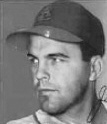
Frazier
The Mets played at Key City Park which was built in 1961. The
park's name was later changed to Franklin Rogers Park and it still
exists.
[To see a photo of Mankato's ball park, you may visit
the website: http://www.digitalballparks.com/
]
Team Highlights:
Spring 1967 - Bismarck-Mandan left the league for the final time and were replaced by a club in Mankato.
9-7-68: The New York Mets said they would not renew their working agreement with Mankato for 1969 due to a lack of "local support".
1969 - Winnipeg returned to the league replacing Mankato for the season which was played between June 22 and September 1.
Mankato club's officers:
1967: Fritz Taylor, president and Dick Peterson, bus. mang.
1968: Taylor, president 
Minot , ND (pop. 25,000+) entered the league in 1958 with an Indians' affiliation and this continued through the 1960 season. The "Mallards" returned for one season in 1962 as an Kansas City A's farm team. Over those four years, they finished fourth three times and eighth once with a combined win/loss record percentage of .479.
They were managed by Ken Landenberger, Walt Novick and Grady
Wilson. Mallards' alumni who made the majors included Sonny Siebert,
Max Alvis, Paul Casanova, Mike delahoz, Chuck Hiller and Larry
Stahl.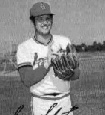
Siebert
The Mallards played at Corbett Field (aka "Mallards Park")
which was built in 1935. The park is still used for amateur games and
the area is now residential on three sides with a parking lot located
on the one side. The dimensions may have changed from it's
professional days, but the park's dimensions are currently 310 feet
down each line, 400 feet to center and 350 to the power alleys. The
dugouts are at the bottom of the grandstand on either side and the
dressing rooms can be accessed from the dugouts.
[To see a
photo of Corbett Field, you may visit the website:
http://www.digitalballparks.com/
]
[For information on Minot's other professional teams, you may go to: http://www.minotmallards.com/ ]
Team highlights:
3-58: Bismarck-Mandan was scheduled to begin play in the Northern League in 1958 as the polar circuit had planning to expand to 10 teams. However, with the withdrawal of Wausau and the addition of Minot, the plan could not be completed.
7-7-58: Minot drew 4,353 fans for a Merchants' Night.
6-20-59: Minot's Hal Jones hit one of the longest home runs ever
in Mallards Park in a game against Eau Claire. He drove a pitch high
over the left-center field wall at the 430 foot mark. The 10th
inning homer tied the score 9-9. but they eventually lost the game
10-9 in 11 innings.
6-4-60: The president of the Minot
Mallards, T.J. McGrath, died. Andrew Bakken, a former president,
returned to that office and William Champlin became the GM of the
club.
3-61: The league was down to six teams with Minot and Fargo-Moorhead having dropped out.
1962 - The league was back to 8 teams as Minot returned and Bismarck-Mandan joined.
4-29-62: Minot drew 3,079 fans who were happy for the return of Northern League baseball to the city.
5-10-62: Minot team officials named Grover Boutin Jr as the GM (business manager) of the team after the resignation of James Bretz. Boutin was also the team president.
5-62: Minot shortened their center and left field fences. Center was reduced from 460 feet to 420 and the left field foul line was changed from 333 feet to 330. The right field foul pole remained at 330 feet.
1962: The team set their season high in attendance of 41,052.
1963 - The league, which was now designed as "class A"
was back to six teams as Minot and Eau Claire dropped out.
Minot
club's officers:
1958-59: Andrew Bakken, president and Herbert Parker, bus. mang.
1960: T.J. McGrath, president
1962: Bakken, president and James Bretz, bus. mang.
Watertown , SD (population 17,000)
had a franchise during the last two
years of the league (1970-71) and were an Expos farm club. They
finished fourth both years with a combined .443 win/loss percentage.
They were managed by Bobby Malkmus and Bob Oldis. Former players who
made the big leagues included Dale Murray, Pat Scanlon, Tony Scott
and Dan Warthen. ![]()
Scott
The club played at a depression-era
concrete stadium that is also used for football. [To see a photo of
Watertown's ball park, you may visit the website:
http://www.digitalballparks.com/
]
Team highlights:
1970 - League membership was changed with Winnipeg dropping out
and Watertown being added.
Watertown club's officers:
1970: R.L. Moffat, president and Howard Lawles, bus. mang.
1971: John McHale, Jr., president
All Time Twenty Game Winners :
Milt Goemer, Grand Forks 1948 25-4
Lloyd Sterling, Winnipeg 1935 24-2
Bob Turley, Aberdeen 1949 23-5
Otto Davis, Brandon 1933 23-13
Charlie Suche, Fargo-Moorhead 1935 22-5
Roy Goldsworthy, Winnipeg 1933 22-6
Mudcat Grant, Fargo-Moorhead 1954 21-5
Bob Clear, Grand Forks 1960 21-6
Russ Loafman, Fargo-Moorhead 1934 21-7
Hugh Orphan, Wausau 1941 21-8
Norm Masters, Crookston 1934 21-11
Mike Kaiserski, Crookston 1938 20-5
Ray Seif, Fargo-Moorhead 1953 20-5
Art Vicital, Fargo-Moorhead 1951 20-8
Don Nance Fargo-Moorhead 1953 20-9
Turley
Ten Game Winners - short season (1965-1971):
Steve Christopher, St. Cloud 1967 12-3
Bob Gebhard, St. Cloud 1965 11-2
Tom Ferraro, St. Cloud 1968 11-3
Lou Billmeier, Duluth-Superior 1970 11-3
John Moncier, St. Cloud 1971 11-1
Mike Colin, St. Cloud 1966 10-1
Steve Spanich, Duluth-Superior 1969 10-2
Buzz Stephen, St. Cloud 1966 10-3
Dave Goltz, St. Cloud 1968 10-3
Goltz
League
Attendance by Year (1947-1964) :
1947 - 647,083
1948 - 609,891
1949 - 661,111
1950 - 554,806
1951 - 491,858
1952 - 513,959
1953 - 503,576
1954 - 518,281
1955 - 454,174
1956 - 338,482
1957 - 376,314
1958 - 347,569
1959 - 342,164
1960 - 344,668
1961 - 207,325
1962 - 320,051
1963 - 225,178
1964 - 251,212
Short Season Attendance (1965-1971):
1965 - 103,832
1966 - 125,219
1967 - 142,844
1968 - 116,230
1969 - 128,964
1970 - 131,157
1971 - 65,040 (4 teams)
Sources:
"An Informal History of The Northern Baseball League" by Herman D. White (former league president)
"The Sporting News"
"The Business of the Pheasants" written and printed by staff of The Dacotah Prairie Museum, Aberdeen, SD
"The Encyclopedia of Minor League Baseball - 2nd Ed.", edited by Lloyd Johnson and Miles Wolff, pub: Baseball America, Inc.
"The Professional Baseball Players Database" 4.0, pub: Old Time Data, Inc.
"The Majestic Atlas of the World - 1933", pub: World Syndicate Publishing Co
"The Aberdeen Pheasants" by Paul Gertsen; Elysian Fields Quarterly 13,1 Spring 1994
www.pacer1.usca.sc.edu/-stadiums/wade
"The Aberdeen American
News"
http://www.digitalballparks.com/
http://football.ballparks.com/CFL/Winnipeg/index.htm
http://www.ballparkreviews.com/siouxfalls/siouxfalls.htm
"A Century of Minnehaha County Baseball" compiled and published by the Rex Stucker Chapter of SABR (1988)
"Baseball In Eau Claire" by Jason Christopherson; pub by Arcadia Publishing (2003)
Topps Company
Grand Forks County Historical Society
Jon Winter
"Ballparks of North American" by Michael Benson; pup:
McFarland (1989)